

Buy Visit Rome Pass, your city pass for visiting Rome. +50 attractions and public transportation included in one tourist card.
✅ Free entrance to the main attractions of Rome ✅ Free public transport
- 7 unmissable World War II sites to visit near Rome
- Places and Tours
Here is where you can see World War II sites in region of Lazio , 7 war landmarks from Rome to Cassino.

June 4th, 1944.
It's a Sunday and the sky is clear over Rome .
General Clark proudly leads the American troops in the liberation of Rome , reaching the Vittoriano buildingat the very heart of the city ,the symbolic place of Mussolini's gatherings. The Roman citizens take to the streets to celebrate the Allies .
The Germans of Field Marshal Albert Kesselring are retreating north , saving further devastation in Rome and Lazio. The Second World War is almost over .
If you've ever wondered where to see World War II sites near Rome, you've come to the right place. We have selected 7 historical sites in Rome and Lazio showing the brutality of the conflict in this part of Italy.
Seven stages for an ideal journey to remember the absurdity of war and to see the scars it left in the Lazio region.
War tourism in the sites of World War II grew a lot in recent years. It should not be considered like a simple recreational activity: war tourism is a moment of study and reflection on an historical period whose consequences still echo strongly today.

The lively harbour of Anzio.
The Anglo-American troops chose the pretty port towns of Anzio and Nettuno for their landing , at the time united in a single municipality called Nettunia.
The troops landed in January 1944 on the beaches north of Anzio: the Levante beach (codenamed X-Ray and reserved to the Americans) and the coastline that goes from Tor Caldara to Tor San Lorenzo ( Peter Beach , attacked by the English).
The Anzio Beachhead Museum (“Museo dello Sbarco di Anzio”) provides an interesting reconstruction of the landing and the fierce fighting that followed, through unique objects , weapons, vehicles, prints and uniforms. Many of these objects have been fished out few hundreds meter from Anzio's port.
The museum is hosted in the halls of the beautiful Villa Adele , about 400 meters from the train station, and is divided into four sections (English, American, Italian and German). Admission is free and it is possible to book guided tours .
The Paradise on the Sea in Anzio (“Paradiso sul Mare”) is a wonderful Art Nouveau building, born as a casino. It was later chosen by General Mark Clark as the headquarters of the allied command. After the war, the Paradiso was used as a film set for masterpieces such as Fellini's “Amarcord” and Alberto Sordi's “Polvere di stelle”.
Anzio is mentioned in a song by Pink Floyd , "When the tiger broke free", dedicated to Roger Water's father , killed near Anzio in the hours following the troops landing.
Anzio and Nettuno are well connected by train to Roma Termini (1-hour journey, around €5), making it a great day trip for history and sea lovers - there's plenty of fish restaurants too.

Il American Cemetery in Nettuno (PH: Stephen Sommerhalter - Own work, CC BY 3.0)
Nettuno is quite a popular tourist destination near Rome, boosting a well-preserved medieval town centre (the Borgo Medievale), with cobbled streets, a fort on the sea and a lively atmosphere .
The Sicily – Rome American Cemetery and Memorial (“Cimitero Americano di Nettuno”) attracts crowds of US and British tourists, mostly war veterans and their families, who gather to commemorate the war years and the fallen comrades. The cemetery is surrounded by trees and it's really well-kept, with thousands of white crosses perfectly aligned along the avenue, making the visit an emotional experience.
The cemetery is the resting place for the bodies of nearly 9,000 soldiers who fell in the various battles of the Italian campaign: an ode to the absurdity of war .
American Presidents Bush and Clinton also visited the cemetery on various Memorial Days.
Anzio and Nettuno are well connected by train from Roma Termini (1-hour journey, around €5), making them a perfect day trip from the capital for sea and history lovers.

5. Bunker of Monte Soratte

The entrance of the bunker of Monte Soratte.
The Bunker Soratte was built in 1937 by order of Benito Mussolini and remained secret for many years. It has recently been turned into a museum, an historical landmark reminding us of World War II and the Cold War .
Over 4 km of complex bunker tunnels were dug inside the southern slope of Mount Soratte, near the municipality of Sant’Oreste (50 km north of Rome).
The bunker has had different functions over the years: before the war, it was an air-raid shelter for high government officials, and in 1943 Field Marshal Kesselring transformed it into the center for the Supreme Southern Command of the German forces in Italy. After the war it became an Army warehouse and then a nuclear shelter.
The guided tour takes visitors through this maze of concrete tunnels at a depth of 300 meters , using materials patiently recovered from the bunker, making the visit very engaging.
The War Room is not to be missed: it was used by NATO and the Air Force as an operations center, this was the room from where Italy would manage its survival following a nuclear attack .
The bunker can only be visited with a booked guided tour at a cost of €10 per person (thanks to the volunteer association called "Bunker Soratte"). The village of Sant’Oreste, the perfect base for a visit, is about an hour's drive from Rome, but it can also be reached from the capital by bus or train, passing through Viterbo.

4. Museum of Piana delle Orme in Latina

The entrance of Piana delle Orme (PH: Giorgio Pietrocola - Opera propria, CC BY-SA 4.0).
Piana delle Orme is a museum featuring 60,000 local artefacts from the recovery of the Pontine marshes through the World War II and the liberation of Rome.
The gem of the museum is the American M4 Sherman tank , used for the 1944 landing, rescued in the sea nearAnzio in 2002. Roberto Benigni borrowed the tank to shoot the famous final scene of his famous 1997 film Life is Beautiful .
The museum is located in Borgo Faiti (a few minutes drive from Latina) within a farmhouse and was founded in 1997, starting from the private collection of Mariano De Pasquale.
Piana delle Orme is divided into a War Path and a Peace Path. The pavilions are mainly devoted to the display of objects from World War II: military vehicles , dioramas, recordings and sound effects depict how Italy became involved in the war following Mussolini’s declaration of war , the North African campaigns, the amphibian landing of the Allied troops near Anzio and the battle for Montecassino.
The Peace Path focuses on peasant life and the recovery of the Pontine marshes in the 1930s. Not to be missed is the fantastic pavilion dedicated to vintage toys .
The museum is also suitable for children and the ticket costs 13€ pp: ideal time visit is 3-4 hours. After the visit, you can buy vintage gadgets from the museum shop or have lunch at the farmhouse restaurant.
3. Montecassino Abbey

The cloister of the abbey with its scenic view.
Perched at 516 metres, the abbey of Montecassino is a Benedictine monastery founded in 529 a.C. from Saint Benedict himself.
Montecassino is the second oldest monastery in Italy (after Santa Scolastica in Norcia). Located near Cassino , south of Lazio region, this majestic abbey boasts a museum, a cathedral, an elegant Renaissance cloister and a spectacular panoramic view .
In mediaeval times, Montecassino was an important religious and cultural landmark . The abbey experienced many turbulent events , including looting (from the Lombards and Saracens) and earthquakes, before becoming the museum we know today.
In 1944, the abbey also witnessed one of the most terrible battles of the Italian front.
The Allies mistakenly believed that German troops were entrenched behind the mighty walls of the abbey, and so they mercilessly bombed the building, razing it to the ground and killing many civilians refugees there. In the useless attack to conquer the abbey, thousands of American soldiers were killed.
The ancient codices of the abbey have been saved from destruction, even though it is thought that some of them found their way to Herman Göring as a birthday gitf.
The abbey was fully rebuilt from its ashes in the aftermath of WWII. Today, Benedictine monks still live in the monastery and visitors can still see them around.
If you have a car , you can reach Cassino in about 2 hours from both Rome and Napoli. Taking the train is also a good option. The admission to the cloister and the cathedral is free , while the entry for the museum is only 5€.
2. The Liberation Museum and the Ghetto of Rome.

The Great Synagogue of Rome on the river Tiber.
Every corner of Rome is a window on a different time o f history: the years of World War II left deep scars , both in the urban planning and in the soul of the Capital.
Best site to start knowing more about WWII in Rome is the Museo della Liberazione ("Liberation Museum"). The museum is open every day and it's free of charge: you can find it at the famous address of Via Tasso 145. This building is sadly known as the place where the Roman anti-fascists were detained by the Nazis.
The Liberation Museum is the perfect place to keep the knowledge of these tragic memories alive for the new generations , thanks to its collection of original documents and the restoration of the cells used by the Germans for tortures .
The district of San Lorenzo is close to the museum and it's the area of Rome that suffered the most from the bombings of July '43 . The many victims of those days are commemorated in the “Parco Caduti" (or "Park for the Fallen of 19 July 1943").
In the Sant’Angelo district, on the other hand, visitors can find the Ghetto of Rome , the second oldest ghetto in Italy. This area of the capital is appreciated by tourists and locals alike for its cultural vitality and for its original restaurants offering Roman-Jewish cuisine (try the famous Giudia artichokes if you are around).
You should visit the Great Synagogue of Rome ("Tempio Maggiore") a wonderful synagogue facing the river Tiber. It's a landmark for the local Jewish community, also housing the Jewish Museum of Rome. If you walk through the streets of the Ghetto, keep your eyes open for the so called pietre d'inciampo (or " tumbling blocks "), small blocks that recall the name of the citizens deported to lagers by the Nazi-fascist forces.
1. Via Rasella and the Fosse Ardeatine Memorial in Rome

Entrance to the monument for the Ardeatine cave massacre (PH: By antmoose - Flickr, CC BY 2.0).
To complete our journey, we recommend visiting two Roman war landmarks: Via Rasella and the Memorial and the Museum of the Fosse Ardeatine .
Via Rasella is the site of one of the most important partisan actions, a bomb that exploded at number 139 hitting a Nazi-Fascist unit on March 24, 1944. On the walls between via del Boccaccio and via Rasella, you can still see the marks of the German machine guns firing in response to the attack.
The Nazis reaction was the retaliation of the Fosse Ardeatine , where 335 innocent citizens were killed in the quarries named "Fosse Ardeatine", later blown up with dynamite to cover their tracks.
This shrine was built in 1949 and includes the massacre caves and the mausoleum where the bodies are buried. The visit to the Fosse Ardeatine is a touching and highly educational experience , to keep alive the memory of the war.
We recommend

Exploring World War II Sites in Italy
Where to Remember the Great War in the Italian Countryside
:max_bytes(150000):strip_icc():format(webp)/martha_bio-56a3c8865f9b58b7d0d3b5fe.jpg)
Italy has many historic monuments, battlegrounds, and museums related to World War II, some in lovely settings that belie the bloody history of the worldwide conflict. Here are a few.
Abbey of Montecassino
One of the most popular sites to visit is the reconstructed Abbey of Montecassino , the site of a famous World War II battle and one of Europe's oldest monasteries. Perched on a mountaintop between Rome and Naples, the Abbey has great views and is very interesting to explore. Allow at least a couple of hours to see everything.
There is also a small War Museum in the town of Cassino, below Montecassino and another on the coast, the Anzio Beachhead Museum , in the center of Anzio near the train station.
Cassino and Florence American Cemeteries
During both World War I and II, thousands of Americans died in European battles. Italy has two large American cemeteries that can be visited. The Sicily-Rome Cemetery at Nettuno is south of Rome (see southern Lazio map ). There are 7,861 graves of American soldiers and 3,095 names of the missing inscribed on the chapel walls. Nettuno can be reached by train and from there it is about a 10-minute walk or a short taxi ride. Also in Nettuno is the Museum of the Landing .
The Florence American Cemetery , located on the Via Cassia just south of Florence, can easily be reached by bus with a stop near the front gate. More than 4,000 identified soldiers were buried at the Florence American Cemetery and there is also s a memorial to missing soldiers with 1,409 names.
Both cemeteries are open daily from 9-5 and closed on December 25 and January 1. A staff member is available in the visitor building to escort relatives to grave sites and there is a search box on the website with the names of those buried or listed on the memorials.
Mausoleum of the 40 Martyrs
This modern memorial chapel and garden called "Mausoleo dei 40 Martiri" in Italian, is located in the town of Gubbio, in the Umbria region of Italy. It memorializes the location where 40 Italian villagers were massacred by retreating German troops on June 22, 1944.
Forty men and women aged 17 to 61 were killed and placed in a mass grave, but despite decades of investigation, authorities have been unable to take the responsible persons to trial: all of the German officers allegedly involved were dead by 2001. The white mausoleum contains marble plaques on the sarcophagi for each of the individuals, some with photographs. The adjacent garden incorporates a wall where the martyrs were shot and protects the original mass grave locations, and forty cypresses line the avenue up to the monument.
Yearly events remembering the massacre are held in June of each year. Open year-round.
Tempio Della Fraternità di Cella
The Temple of Fraternity at Cella is a Roman Catholic sanctuary in the town of Varzi, in the Lombardy region. It was constructed in the 1950s by Don Adamo Accosa, out of the broken remains of churches throughout the world which had been destroyed in the war. His first ventures were helped by Bishop Angelo Roncalli, who later became Pope John XXIII and sent the first stone to Accosa from an altar of a church near Coutances, near Normandy in France.
Other pieces include the baptismal font was built from the turret of the Naval battleship Andrea Doria; the pulpit is made from two British ships who participated in the Battle of Normandy. Stones were sent from all the major conflict sites: Berlin, London, Dresden, Warsaw, Montecassino, El Alamein, Hiroshima, and Nagasaki.
A Travel Guide Recommendation
If you're interested in visiting a few of these sites, the book A Travel Guide to World War II Sites in Italy makes a good companion. Available both on Kindle or in paperback, the book has details about visiting many sites with visitor information for each including how to get there, hours, and what to see. The book also has maps and photos taken in Italy during the war.
Liberation Day Observances in Italy
8 Best Things to Do in Vatican City
Top 15 Monuments and Historic Sites in Paris
Visiting Montecassino Abbey
The 14 Best Day Trips from Rome
Top Normandy D-Day Landing Beaches and World War II Sites
20 Best Things to Do in Florence, Italy
The 26 Best Washington, D.C. Monuments and Memorials
Monasteries to Visit in Italy
Moscow - Russian Rivers and Waterways Port of Call
Lazio Region Travel Maps
A Tour of World War I Memorials in France
World War I Meuse-Argonne American Military Cemetery
Visit 8 United States War Memorials That Honor the Fallen
North Coast of France: The Ultimate Road Trip From Dieppe to Calais
Asia's Arlington: The Manila American Cemetery in the Philippines
A Travel Guide to World War II Sites in Italy
Book review.
From battlefields and cemeteries to museums and monuments, Italy has many important sites from World War II. Whether you’re a history buff or just want to visit some interesting places, these sites make good additions to your itinerary. To find out where to go and plan your visits, I highly recommend this comprehensive guide book by Anne Saunders:
- A Travel Guide to World War II Sites in Italy: Museums, Monuments, and Battlegrounds
Probably the most well-known site from World War II is Monte Cassino Abbey , the site of one of the war’s most important battles. Almost every city and town has a war memorial to its fallen soldiers. But there are many other places you probably don’t know and wouldn’t find on your own. Anne’s book will help you discover them.

A Travel Guide to World War II Sites in Italy is a very well-organized and easy to use guide. It has everything you need to visit the sites including addresses and GPS coordinates, background information, travel notes, information about what to see, and web sites when applicable. Almost 200 sites are included, most of which the author has personally visited. Historical information is presented in an interesting and easy to understand manner so it’s not necessary to have prior knowledge.
The book is divided into 20 chapters, starting with an introduction to World War II in Italy. The following chapters are divided by Italian regions starting from Sicily in the south and ending in Trieste in the north. Each of these regional chapters are arranged to be used as an itinerary or you can choose a couple of places to supplement your own itinerary.
Excerpts from the journal written by an American officer during his time as a prisoner of war in Italy, included in the appendix, add a personal touch. Black and white photos in the center section reference the chapter where the site can be found.
- See more photos of memorial sites on the book’s web site.
This book is an updated version of Anne’s previous book. It includes additional Italian regions and sites, updated visiting information, and GPS coordinates. I read the first book, using it to visit several sites and found it to be excellent. It had everything I needed to know, even though I am not well-versed in World War II history, and really made the places come alive for me .
With the additional coverage, this new guide is even better and still compact enough to carry around with you easily. It’s also great for armchair travel for anyone interested in history or just wanting to learn more about World War II.

Disclaimer: I was provided with a review copy of the book by the author, however that did not influence my opinion.
This post may contain affiliate links to sites I believe are of benefit to travelers. There is no cost to you but the small amount of revenue helps defer the cost of bringing you this free information.
Related Articles
Italy Gift Books
Venice Historical Fiction
Eternally Artemisia Author Interview
Book Review: All the Way to Italy
Book Review: Waking Isabella
Author Martha Bakerjian Categories Recommended Reading , Historic Sites
Italy Facebook Page Email Me
Commenting is closed for this article.
A Travel Guide to World War II Sites in Italy originally appeared on MarthasItaly.com Jan 24, 2018 , updated: May 21, 2019 by Martha Bakerjian .

- ESCORTED TOURS
- Basilica di Santa Maria
- Galleria Borghese
- Gianicolo Park
- Giorgio de Chirico House Museum
- Hadrian’s Villa
- Roman Forum
- San Luigi dei Francesi
- Spanish Steps
- Tivoli Gardens
- Trevi Fountain
- Doge’s Palace
- Gallerie dell’Accademia
- Piazza San Marco
- Ponte di Rialto
- St. Mark Basilica
- Boboli Gardens
- Duomo di Firenze
- Oltrarno Quarter
- Ponte Vecchio
- Palazzo Pitti
- Uffizi Gallery Museum
- Herculaneum
- Vietri sul Mare
- Campo dei Miracoli
- Camposanto Monumentale
- Duomo di Pisa
- Museo Nazionale di San Matteo
- Palazzo Reale
- Santa Maria della Spina
- Monteriggioni
- Palio di Siena
- Piazza del Campo
- Piccolomini Library
- Santa Maria della Scala
- San Gimignano
- Vatican City
- Testimonials
- Quick Contact
- Escorted Tours
- Personalized Tours
- Group Tours
- Honeymoon in Italy
- Tickets & Activities
- Italy Travel Guide
- Italy Articles
- Virtual Italy Tours
- Travel Resources
- Summer in Italy
- Winter in Italy
- Spring in Italy
- Italy Vacation Checklist
Yes! Please send me my FREE Insider Italy Vacation Checklist with the insider travel secrets I'll need for a perfect Italy vacation.
CALL OUR TRAVEL EXPERTS
Let us help you plan your dream trip to Italy. Call or email us and a Travel Expert will get back to you within 24 hours.

- All Destinations
- United States
- European Theater
- Pacific Theater
- The Home Front
- The Holocaust
- Pearl Harbor
- WWII Events
- Wings, Wheels, & Weapons
- General WWII Travel Topics
- Work With Me
- Skip to main content
- Skip to primary sidebar
DESTINATION: WWII
A World War II Travel Blog
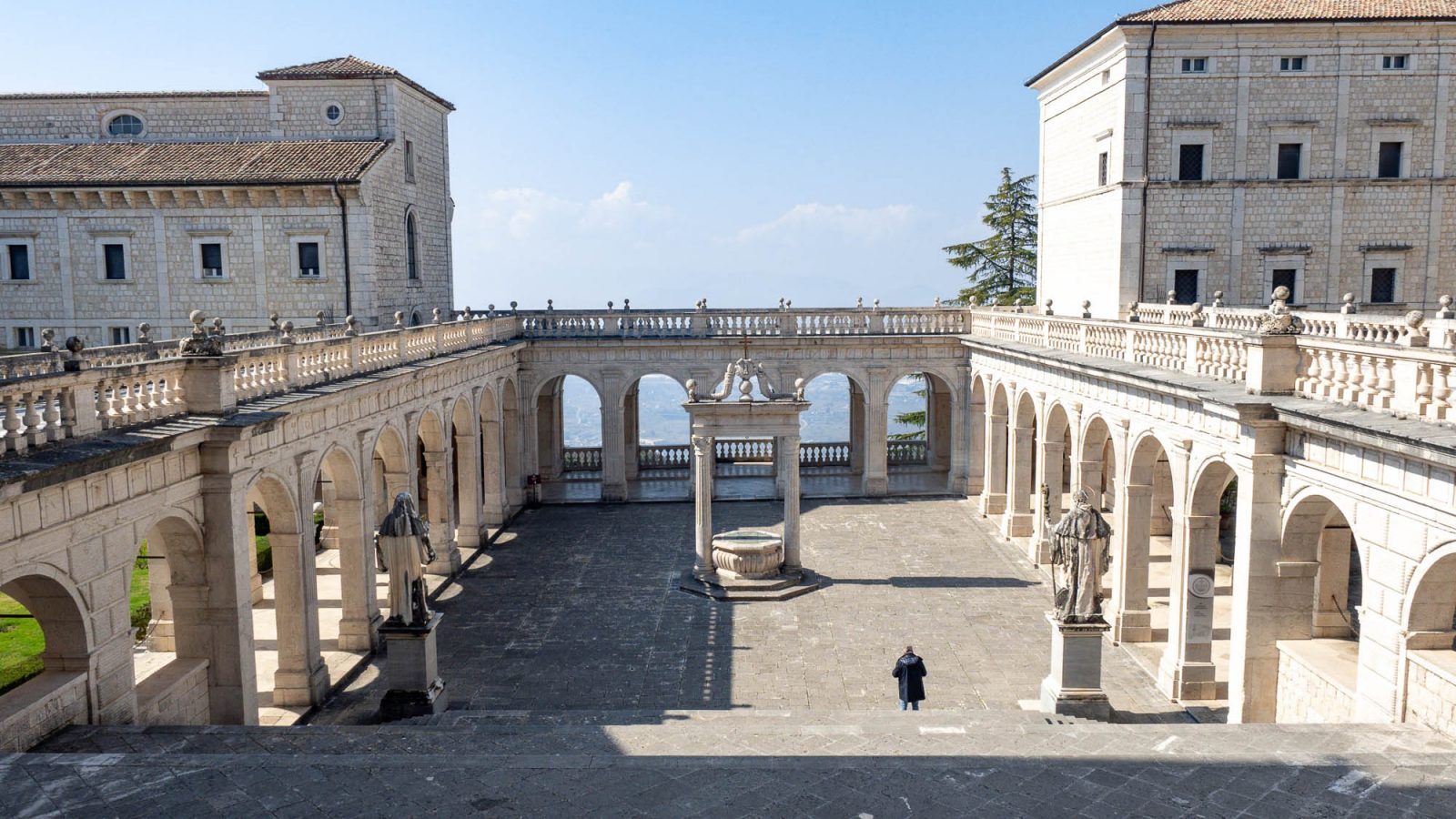
Explore WWII History in Cassino, Italy at These 10+ Significant Sites
Last Updated: April 15, 2023 // by Ashley Smith Leave a Comment
Of all the World War II sites in Italy , those in the city of Cassino are among the most noteworthy. (Monte Cassino itself is arguably one of the most visited WWII sites in the whole country.) Conveniently located halfway between Rome and Naples, Cassino is easy to visit and offers enough WWII history for an enriching day or two on your Italy road trip.
Table of Contents

WWII history in Cassino, Italy
After landing at Salerno in Operation Avalanche , Allied troops made their way north toward Rome. But by January, they had become stalled at the Gustav Line—the most heavily defended German defensive line across Italy. The key point in the Gustav Line was the town of Cassino, notable for a massive abbey atop a dominating hill that overlooked the entire region (Monte Cassino).
The “Battle for Cassino” is actually made up of four battles that lasted from January to May 1944. The objective was to break through the Winter Line where they would have a clear road to Rome. (The Winter Line was what they called the Gustav Line + the smaller Bernhardt and Hitler Lines.) Though the German defenses did slow down the Allies for a time, the final result was Allied victory. Rome was then liberated one month later.
This 3.5-minute video by Poland’s Ministry of Foreign Affairs sums up WWII history in Cassino.
Ultimately, the Battle for Cassino resulted in over 55,000 Allied casualties, 20,000 German ones, and 2,000 civilian losses. The historic abbey was almost completely destroyed, but not before the monks and priceless treasures could be relocated.
Subscribe to DWWII
Wwii sites in cassino today.
Today, you can visit the world famous hilltop abbey at Monte Cassino, as well as a number of surrounding cemeteries, memorials, and museums. Down in the town itself, WWII history in Cassino is still very much front and center for its residents. You’ll be able to see this in many memorials and war remnants around town.
Most visitors to Cassino come to see the monastery and then move on. But, there’s so much more to see that it’s worth staying in town for at least a full day or two! Here are 10+ of the most significant spots you should check out while exploring WWII history in Cassino, Italy:

1. Monte Cassino Abbey (Abbazia di Montecassino)
The first abbey on this site was constructed way back in the 500s AD, but it was already an ancient worship site before that. After that one was sacked by invaders, another was built in 718 AD. It was sacked again in 883, then rebuilt in 949. After centuries of use and decline, a devastating earthquake, and further sacking, what was left would stand until World War II.
Even though this longest-lasting of the monasteries was within a protected historical zone, the Allies still believed the Germans were using it as an observation post. So, they destroyed it with bombing raids in February 1944. (This is super controversial, by the way.)
But guess what? The abbey at Monte Cassino, true to form, was rebuilt yet again in the 1950s and 60s. And that’s the abbey you can visit today. And she’s a beaut.
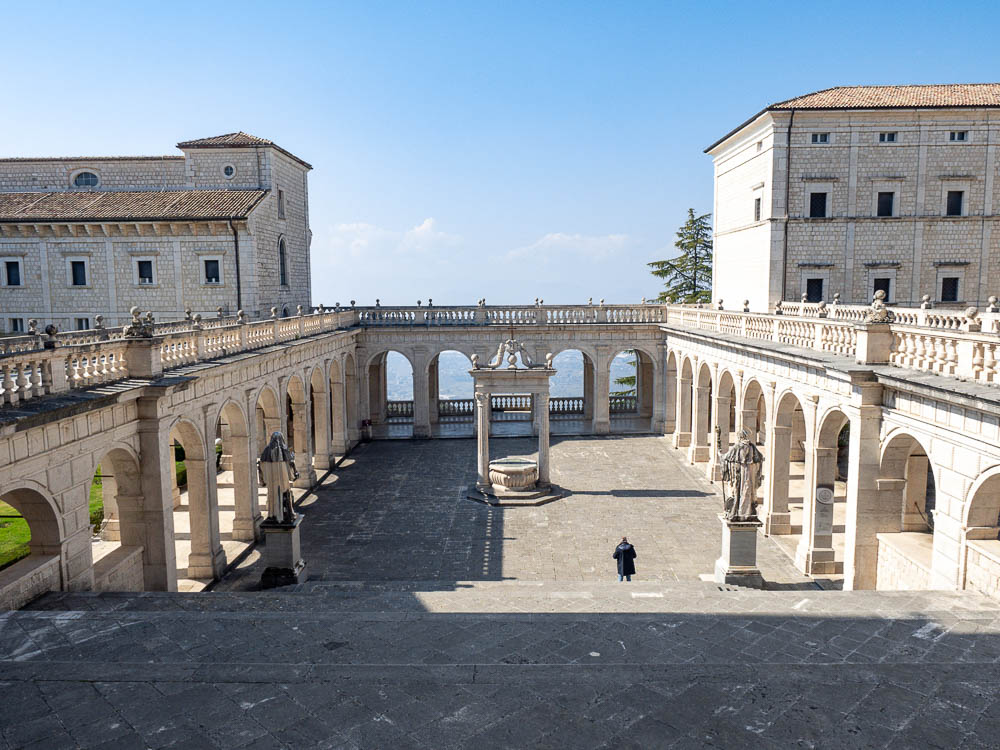
Visiting Monte Cassino today
Though what you see today at Monte Cassino is still somewhat “new,” it’s been rebuilt in the same way, in the same place.
You can easily visit by driving up to the abbey and just heading inside. The site is free to visit and some parts are always open to the public so you can walk around without a guide. See their official website here.
You can explore the cloisters and look out over the entire valley below and far into the distance. You can also visit the basilica and crypt free of charge. For a small fee, you can also visit the abbey’s museum (but only on the weekends).
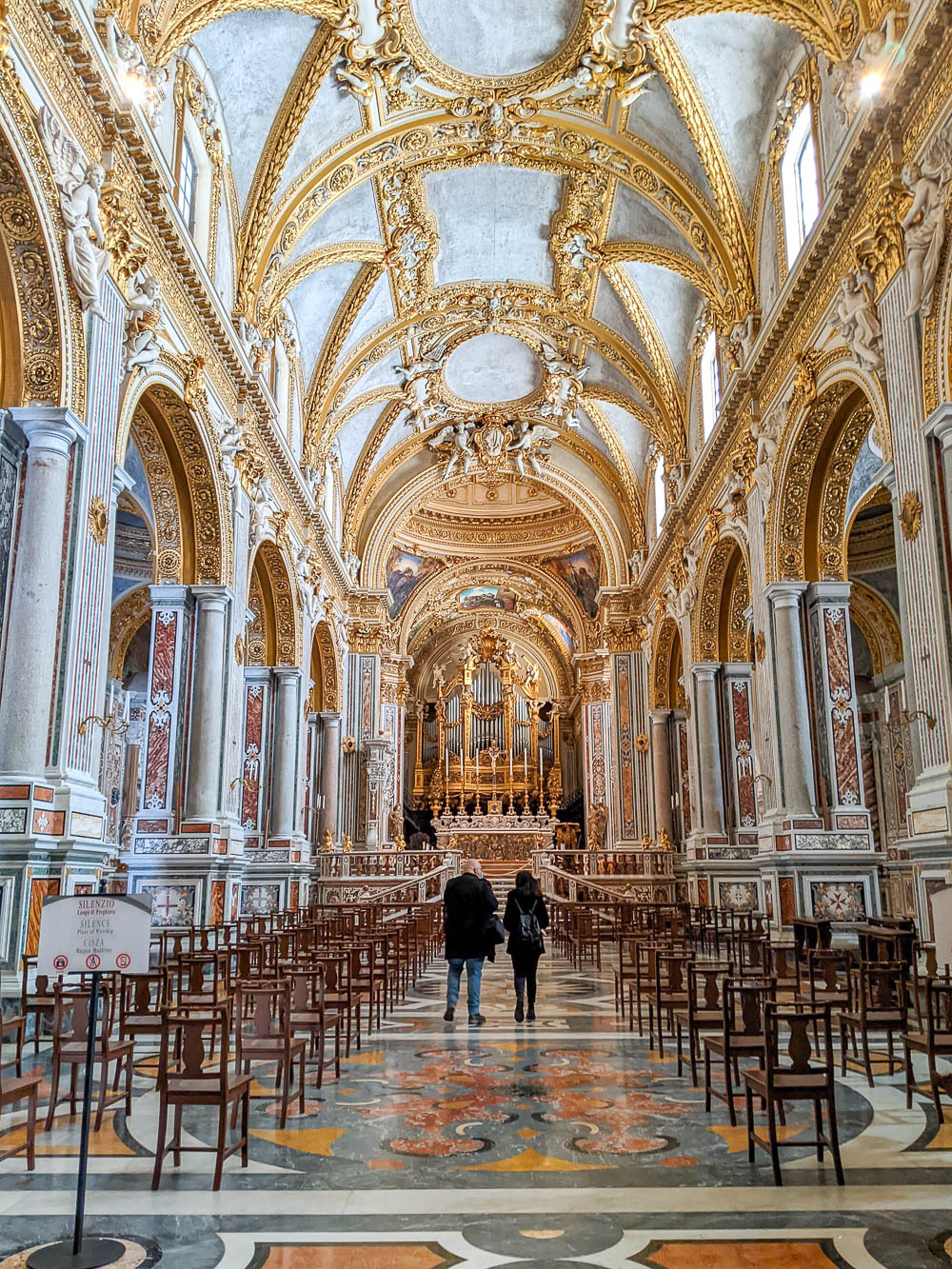
You can also book a guided tour . This includes a visit to the “Old Area” of the abbey, the small bit of original abbey that was not destroyed in the 1944 bombing raids. This is your chance to learn all of its history and its role in World War II. (They do ask you book these as much in advance as possible.)
How to get to Monte Cassino Abbey
Here are a few different ways you can easily visit the Monte Cassino abbey:
Driving to the Abbey at Monte Cassino could not be easier, provided you can follow your GPS. (Though the roads up are windy and steep!) Parking is available on site for €3. If you still need a car for your Italy trip, check out rentalcars.com for some great local deals.
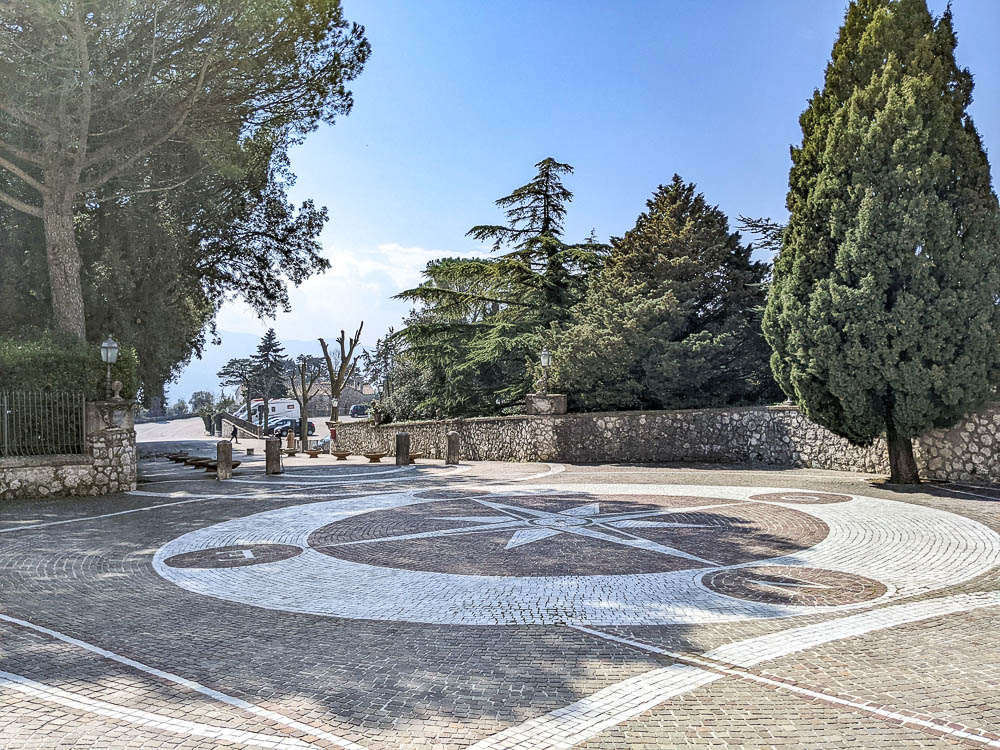
It is also possible to get to the abbey by way of the train system (+ bus). From wherever in Italy you are, take the train to Cassino. From Cassino’s main train station, a bus for the abbey leaves daily at 9:55am, 12:30pm, and 3:15pm. (It leaves the abbey bound for the train station at 10:20am, 12:50pm, and 5:10pm.)
To book these tickets is equally as simple. On the TrenItalia website, enter “Cassino Abbey” as your destination and it will include the train + the bus ticket you’ll need to get there. (Your destination will be Cassino Abbazia if you’re shopping in Italian.)
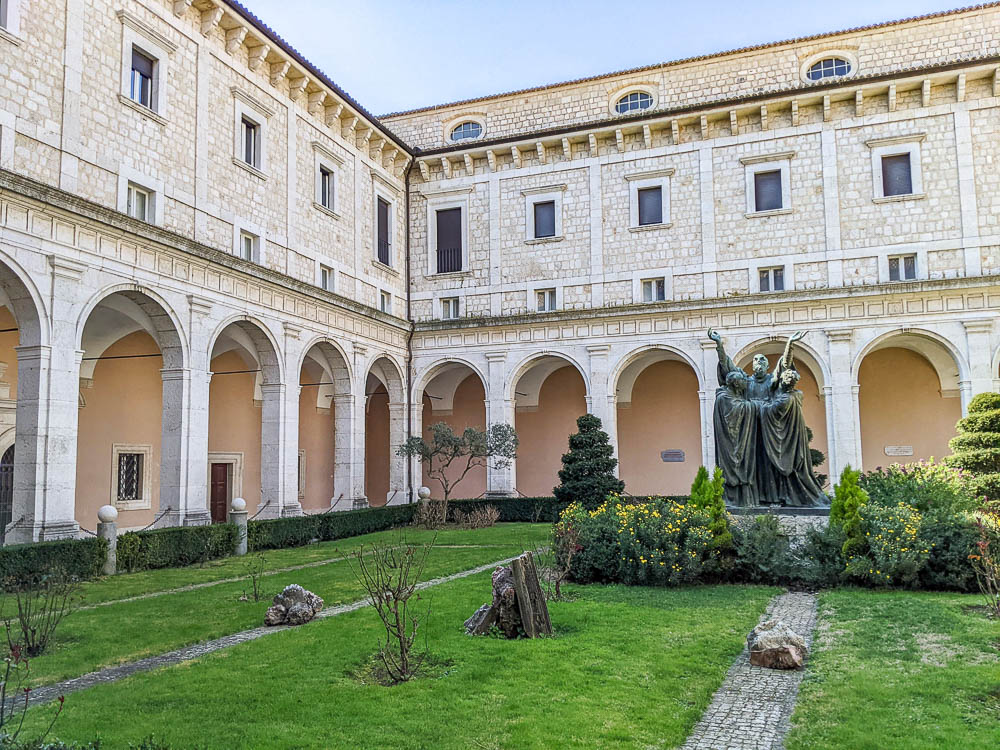
Organized tours of Monte Cassino Abbey
Another super easy way to visit Monte Cassino by doing the bare minimum travel planning is to book a fully organized tour. This way, you simply have to pay and show up while everyone else handles the logistics. Here are a few of the most popular Monte Cassino tours:
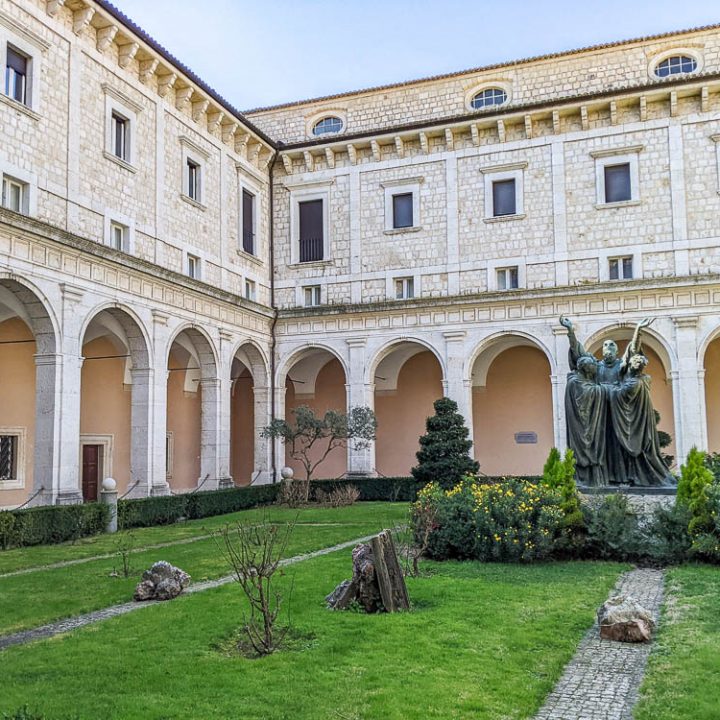
Monte Cassino and WW2 Battlefield Tour by Anna
This 3-hour tour of Monte Cassino and the surrounding battlefields led by Anna, a local historian and tour guide, is a crowd favorite.
You'll have your own private air-conditioned minibus and will enjoy a personalized tour.
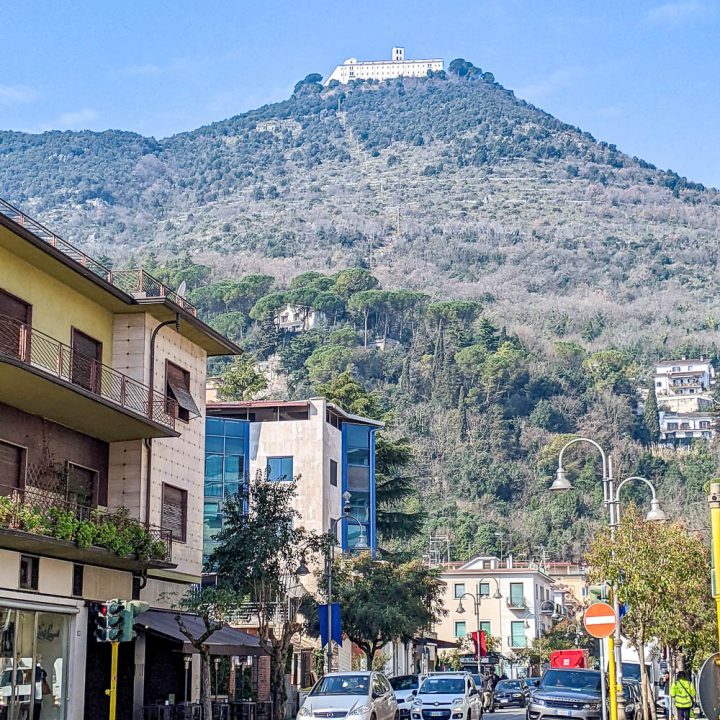
Full Day Monte Cassino Day Trip from Rome
This 7-hour day trip takes you from your hotel in Rome to the WWII sites in Cassino and back. On this fully guided tour you'll visit the Monte Cassino abbey as well as the Polish and Commonwealth war cemeteries.
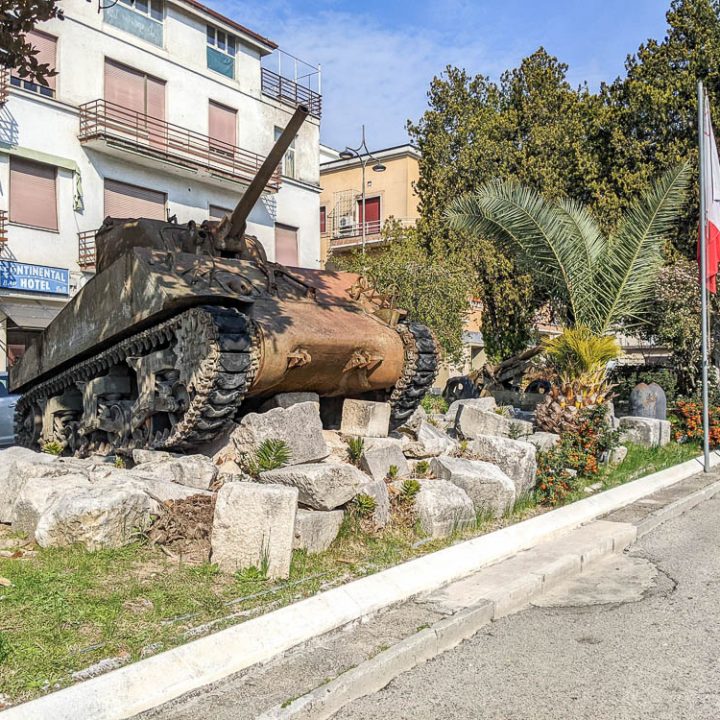
Montecassino Abbey & Anzio War Cemetery day-trip from Rome
Another great trip from Rome is this one that includes both the Monte Cassino abbey and a visit to the Commonwealth war cemetery at Anzio, one of the major Allied landing beaches.
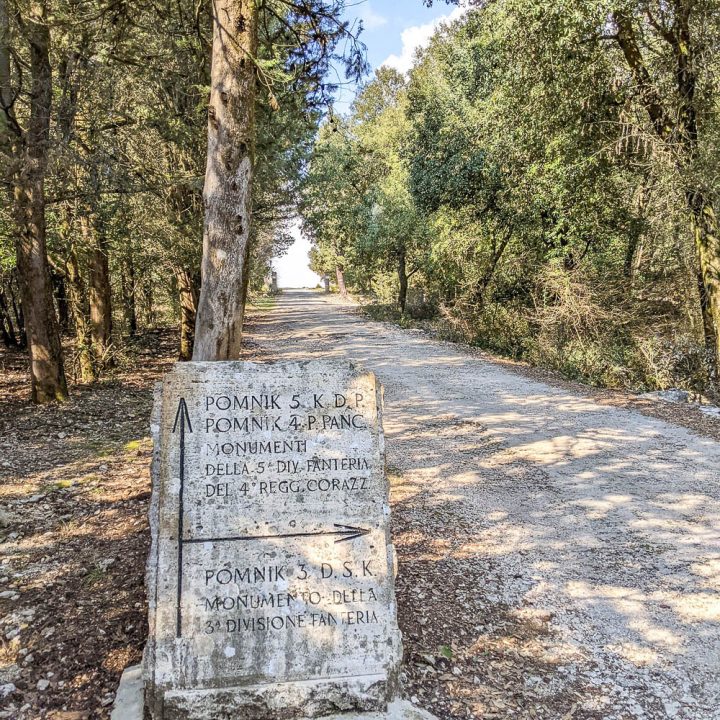
Footprints on the Battlefield Trails of Monte Cassino
As far as Monte Cassino tours go, this one is totally unique. If you'd like to spend some time outdoors on your visit, check out this guided tour of the area's battlefield trails. You'll learn all about the Battle of Monte Cassino and see key areas from the soldiers' points of view.
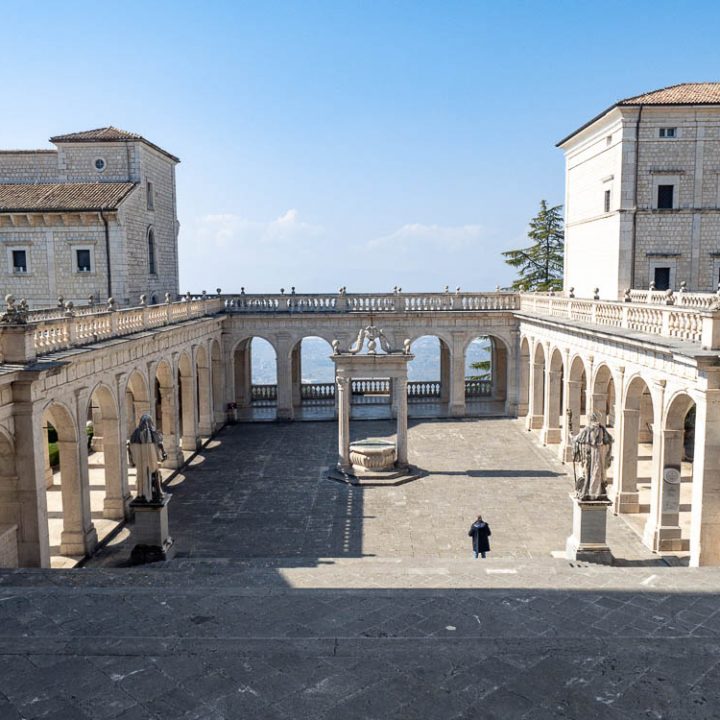
All other Monte Cassino tours
There are a number of worthwhile Monte Cassino tours to check out actually, and from starting points other than Rome and Cassino too. See them all here and find the best one that fits with your trip.
Non-WWII Fun Monte Cassino Fact : There is a series of trails off the parking lot for the Polish War Cemetery (next on this list) that will take you through the woods to, among other locations, the monastery’s brewery . Break up your day of somber history with some great abbey beers in a quiet spot that feels like it’s in the middle of nowhere. (Follow the trail signs marked birrificio .)

2. Polish War Cemetery
The last of the four battles at Monte Cassino fell largely to Poland’s 2 nd Army Corps. Its general Władysław Anders believed that by fighting this crucial battle Poland would be able to prove its loyalty to the Allies and all other enemies of Nazi Germany.
Though this and the entire Battle for Cassino resulted in an Allied victory, 1,079 Polish soldiers lost their lives. Almost 3,000 more were wounded and 345 were never found. Of those who didn’t survive, 1,066 were laid to rest just outside the grounds of the monastery in what is now the Polish War Cemetery.
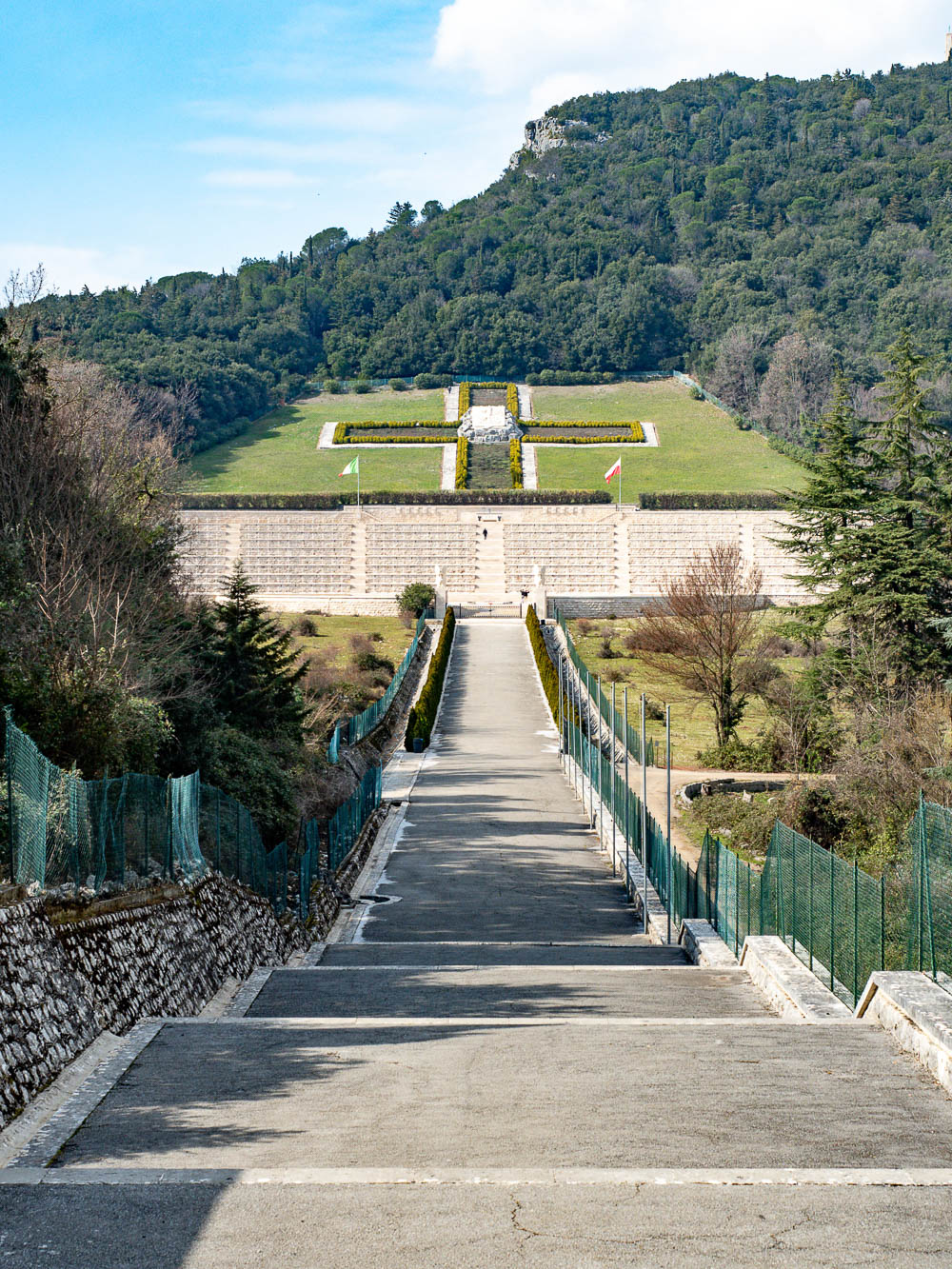
The Polish War Cemetery is massive, and appears even more so when you see it from the balcony of the abbey. It’s full of meaningful sculptures and memorials. The cemetery is an easy drive just a few minutes from the monastery, and you’ll find a free parking lot just outside.
3. Memorial Museum of the 2nd Polish Army Corps in Monte Cassino
At the entrance to the Polish War Cemetery is the Memorial Museum of the 2 nd Polish Army Corps in Monte Cassino . (Known in Italian as Museo Memoriale del 2° Corpo d’Armata Polacco a Montecassino and in Polish as Muzeum Pamięci 2 Korpusu Polskiego na Monte Cassino. )
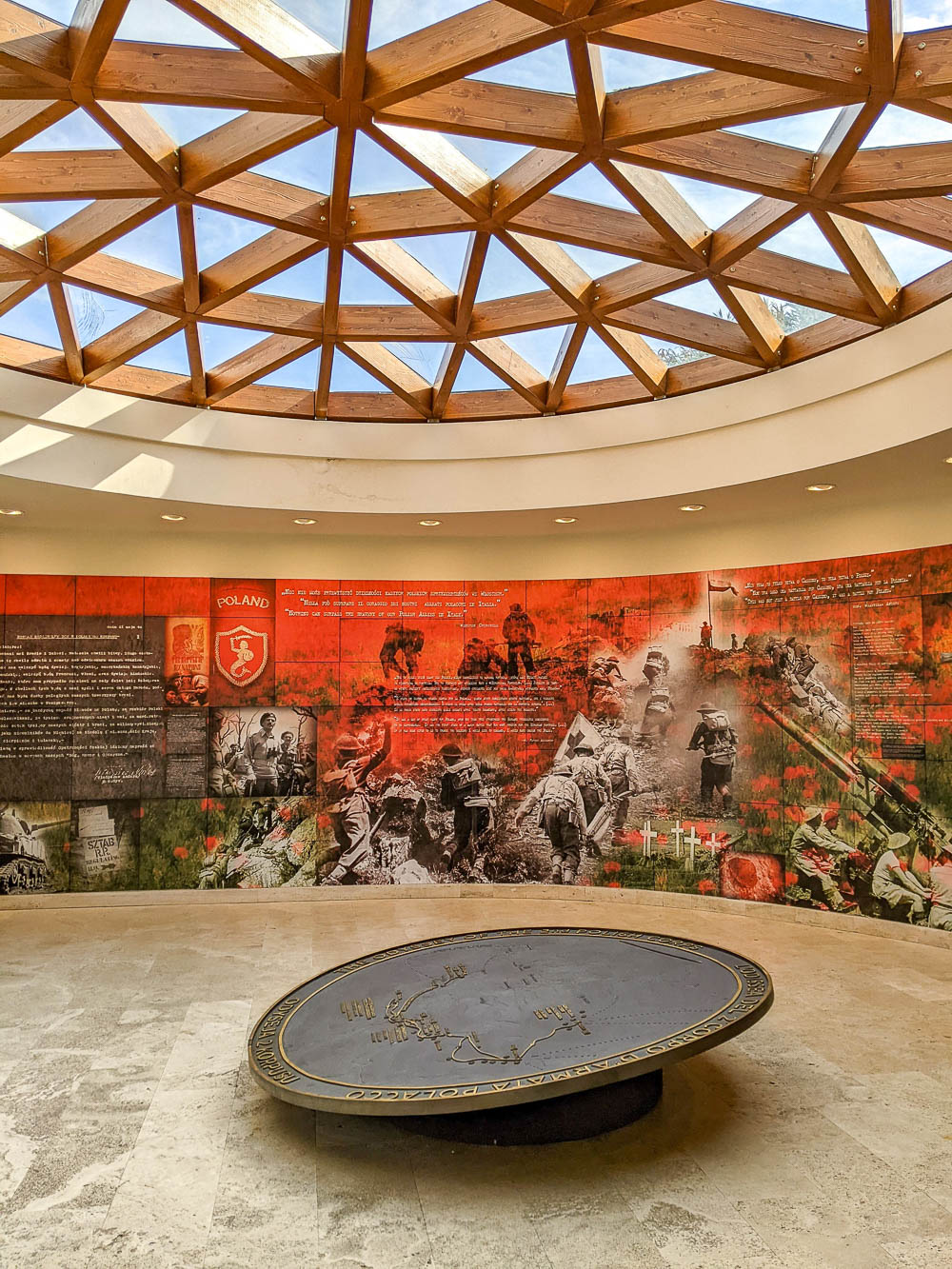
This small but informative museum tells the story of the Polish contribution to the Battle of Monte Cassino as well as Poland’s history during both the German occupation and the Soviet occupation.
Beyond Cassino, you can also learn about the Polish Army’s actions throughout the Italian campaign and more. You’ll also get to see a collection of artifacts, some of which were only discovered in 2020. The exhibits here are captioned in English, Italian, and Polish. The employee on site the day I visited also gave me a full rundown of Polish war history.
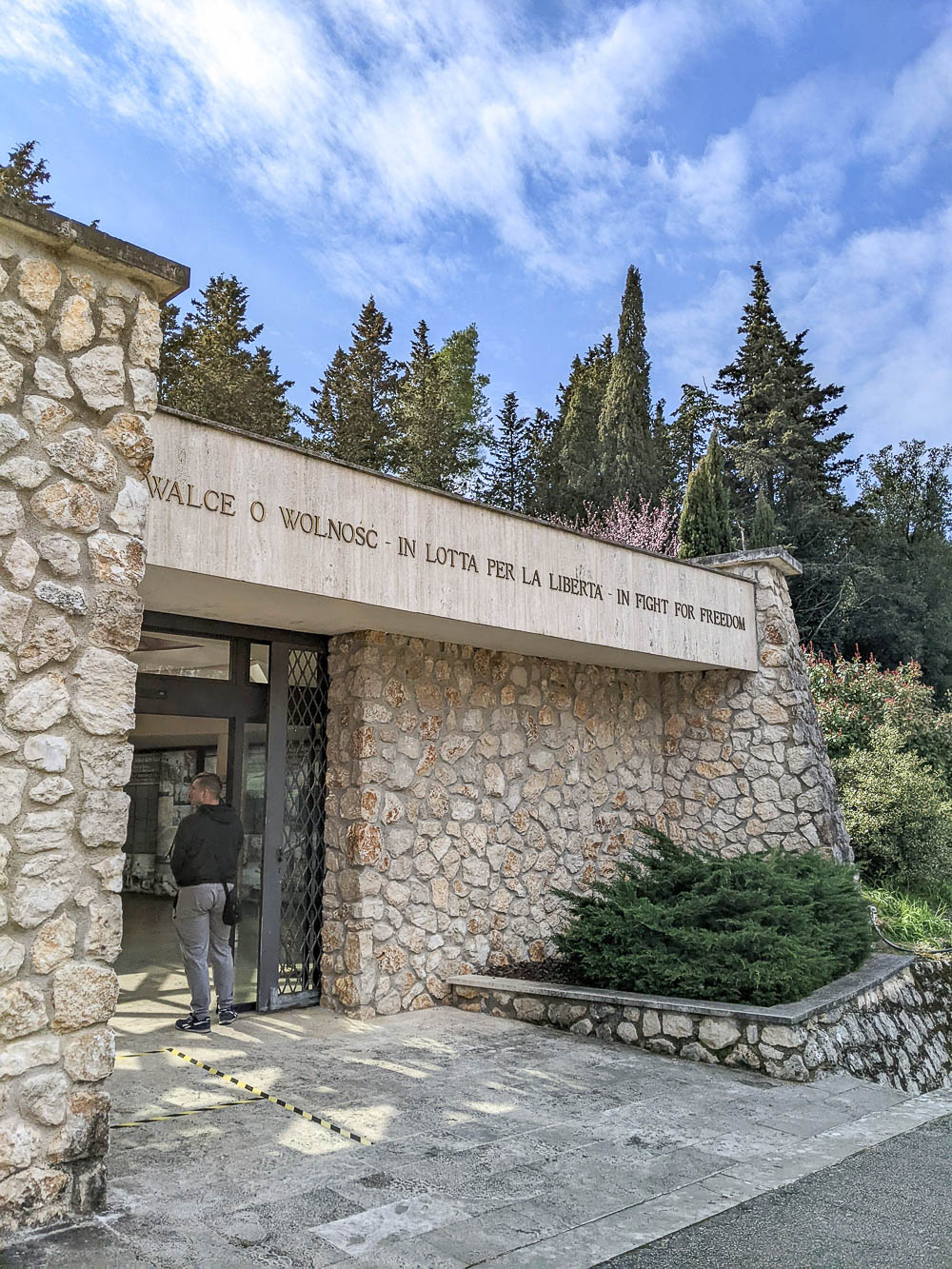
4. Monument to the 3 rd Carpathian Rifle Division on Hill 593 at Monte Cassino
The Monument to the 3 rd Carpathian Rifle Division on Hill 593 at Monte Cassino is a massive hilltop memorial that honors the Polish soldiers who died at Monte Cassino and in the greater Italian campaign. The name comes from the Polish infantry division that took Hill 593 (Mount Calvario) during the Battle of Monte Cassino in May of 1944.
It was designed by Tadeusz Zandfos, an architect and captain of the 3 rd Carpathian Rifle Division, and built by men of the 2 nd Polish Army Corps. It was inaugurated in July 1945 but refurbished in 2020 which is why it looks so shiny and new.
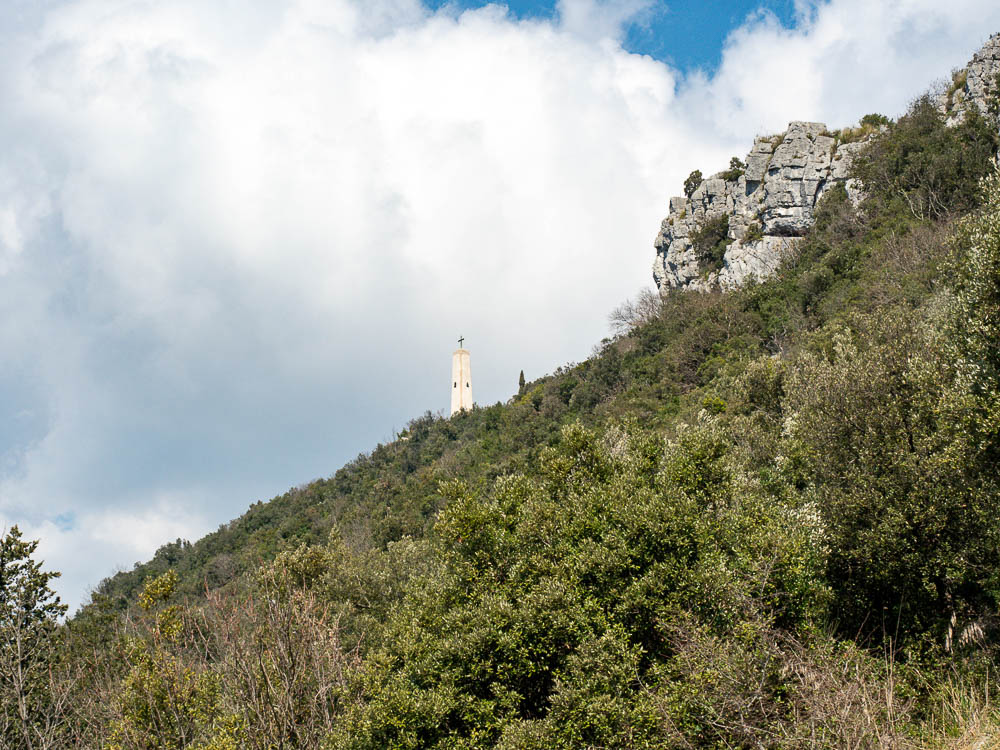
Supposedly , you can easily walk here from the Polish cemetery via a path and some stairs. But I’m not gonna lie to ya – this is where I was trying to go when I stumbled upon the brewery. (And from there, this monument appeared light years away. I blame jet lag.)
From the parking lot at the cemetery, there is a trail marker that points the way to the monument, but I must have taken a wrong turn in the woods somewhere. (One that led to beer though, so I’m not mad about it.) I will try again on my next visit, but my advice to you would be to ask the staff in the Polish museum how to get there, just to be sure.
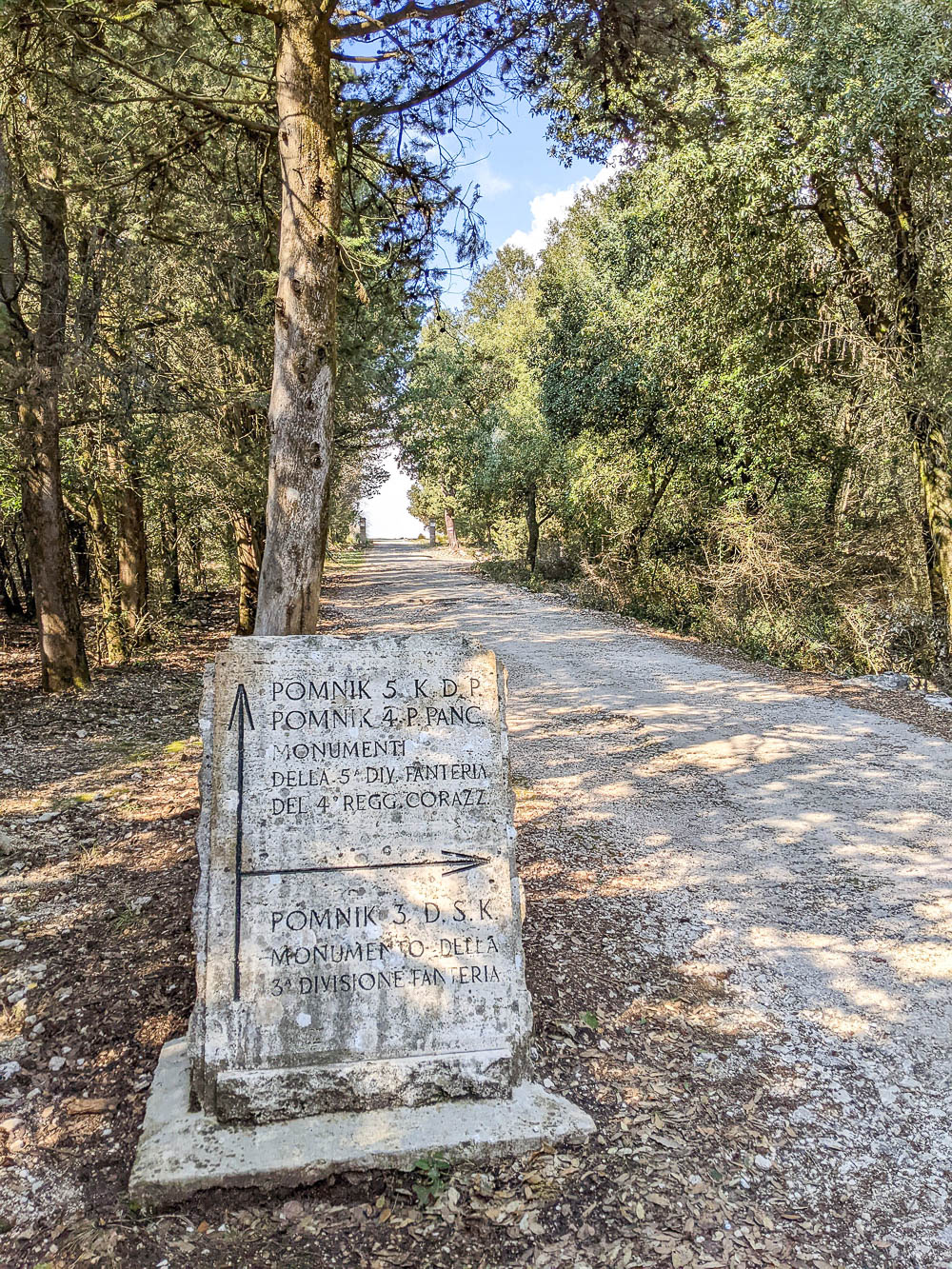
5. Polish tank memorial (Monument to the 4 th “Skorpion” Armored Regiment)
This Polish tank memorial is a memorial erected from the remains of a Sherman tank that exploded after rolling over a mine on the morning of May 12, 1944. The entire tank crew was killed and the commander of Poland’s 2 nd Armored Brigade demanded a memorial be constructed in their honor.
The memorial consists of a cross made from the tank’s tracks that stands on the tank’s wreckage and two bronze plaques, surrounded by a small rock wall.
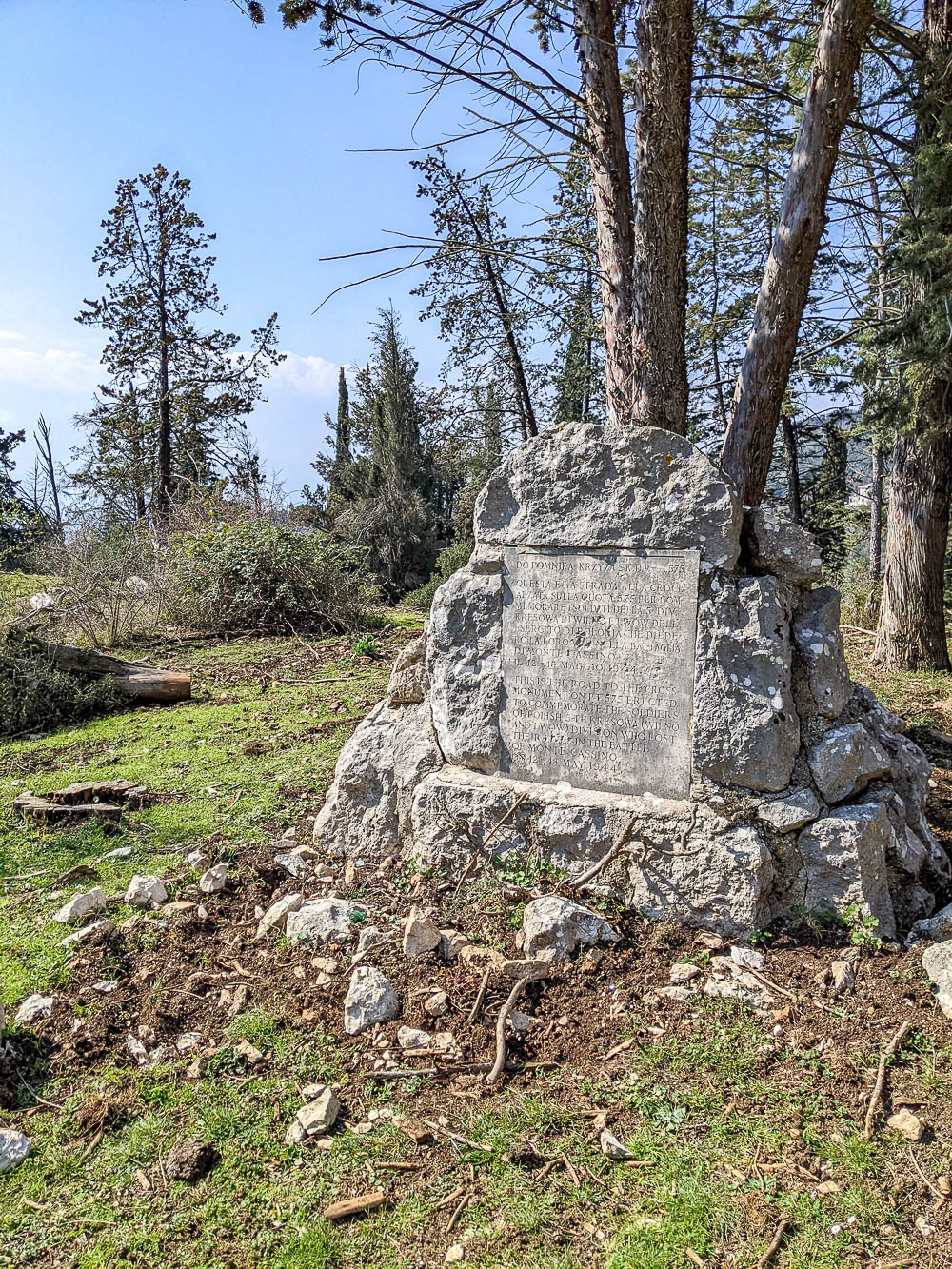
6. Memorial to the 5 th Kresowa Infantry Division
This third Polish war memorial is located atop Hill 575. It consists of a giant cross constructed out of steel from the Bailey Bridge and honors the 503 men of the 5 th Kresowa Infantry Division who died in fighting at Cassino and the 1,531 more who were wounded.
This location was chosen for its height and visibility from the monastery, but also because Hill 575 was the division’s main goal upon breaking through the Gustav Line. The road to this monument was constructed specifically for this purpose.
7. The Albaneta War Memory Path
The Albaneta is the name given to a complex of sites around the Monte Cassino area. It encompasses:
- the Monte Cassino brewery
- the three memorials listed above
- a working farm
- tons of trails
- and the estate of the Benedictine fathers of Montecassino which itself includes the ruins of two ancient abbeys – the Monastery of Santa Maria dell’Albaneta and the Monastery of San Matteo Servorum Dei

You are welcome to walk this entire area and visit the sites, but they have also put together a series of walking routes for your enjoyment. The one we’re most interested in is the War Memory Path . It leads you around through the Albaneta and specifically to the three Polish memorial sites.
Rather than roam around the mountain aimlessly like I did (because I didn’t yet know such an organized route existed), take a look at the War Memory Path which includes walking routes and information like elevation gain/loss and historical background on each of the memorials.
8. Cassino War Cemetery
Just down the mountain from the Monte Cassino monastery is the Cassino War Cemetery. This Commonwealth cemetery contains the graves of 3,992 World War II casualties. Here, you’ll find the graves of those who took part in the Battle of Cassino and surrounding areas who hailed from: Canada, New Zealand, United Kingdom, India, South Africa, and Australia. Plus, 289 unidentified.
At the Cassino War Cemetery you’ll also find the Cassino Memorial that honors the more than 4,000 Commonwealth soldiers who were never found.
The Cassino War Cemetery is only open during certain hours at different times during the year. Be sure to check this website for the most current hours.
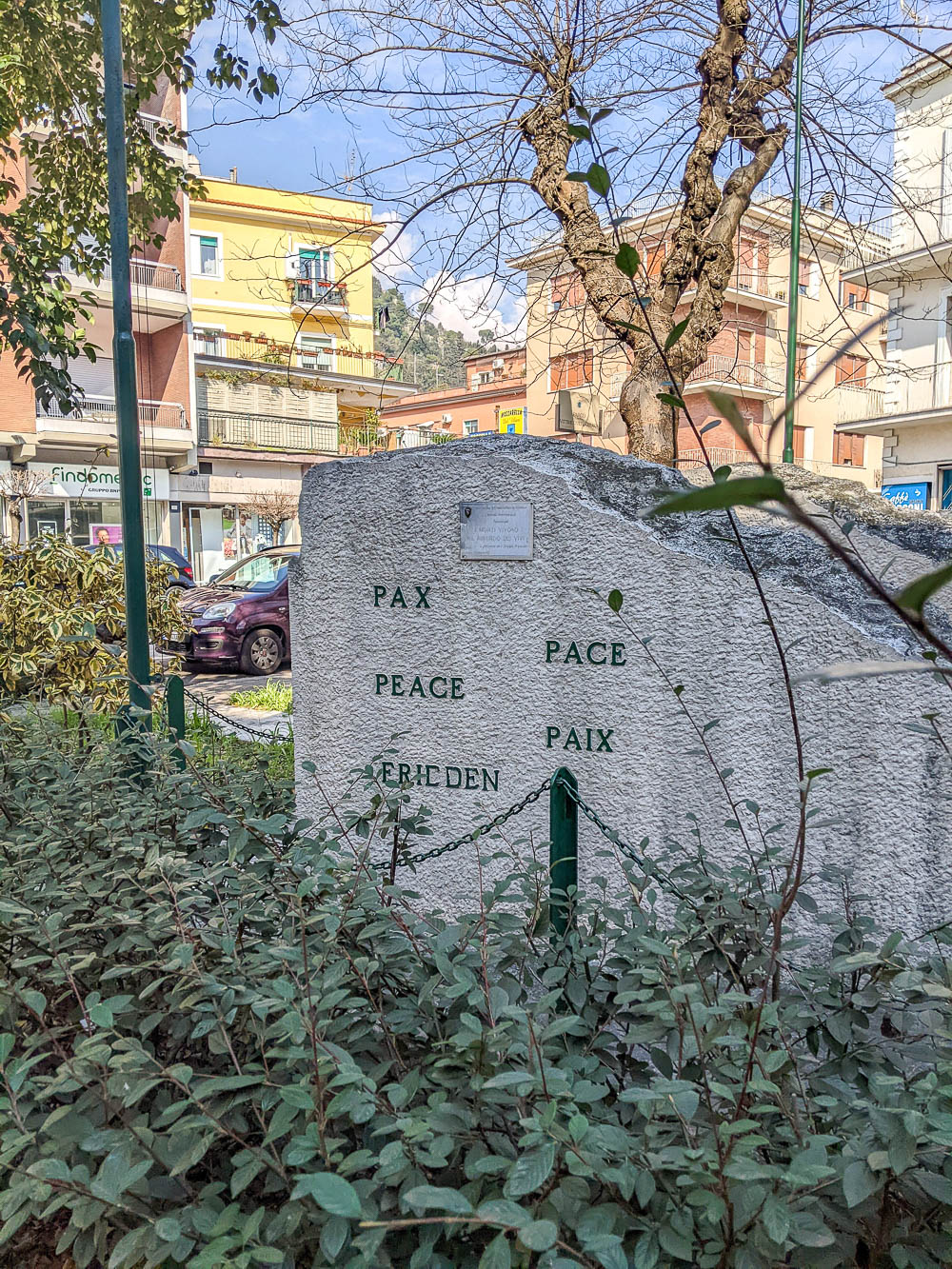
9. German War Cemetery Cassino
It’s not lost on me that visiting a German World War II cemetery might seem a bit… uncomfortable? Treacherous? But I do still feel it’s important. I talk more about this in my post on Normandy sites to visit where I include a visit to La Cambe German Cemetery among those I most recommend.
The German military cemetery in Cassino is actually about 20 minutes north of the monastery in the village of Caira. In it you’ll find the graves of the more than 20,000 German soldiers who died in the fighting at Cassino and southern Italy, including Salerno . This cemetery covers an entire hill and features a few works of art and even a lamp donated by Pope Paul VI.
For more information, location, and visiting hours, etc., check out their official website here , but it’s only available in German. Enter that URL into Google’s website translator for easy reading if you spreche kein Deutsch .
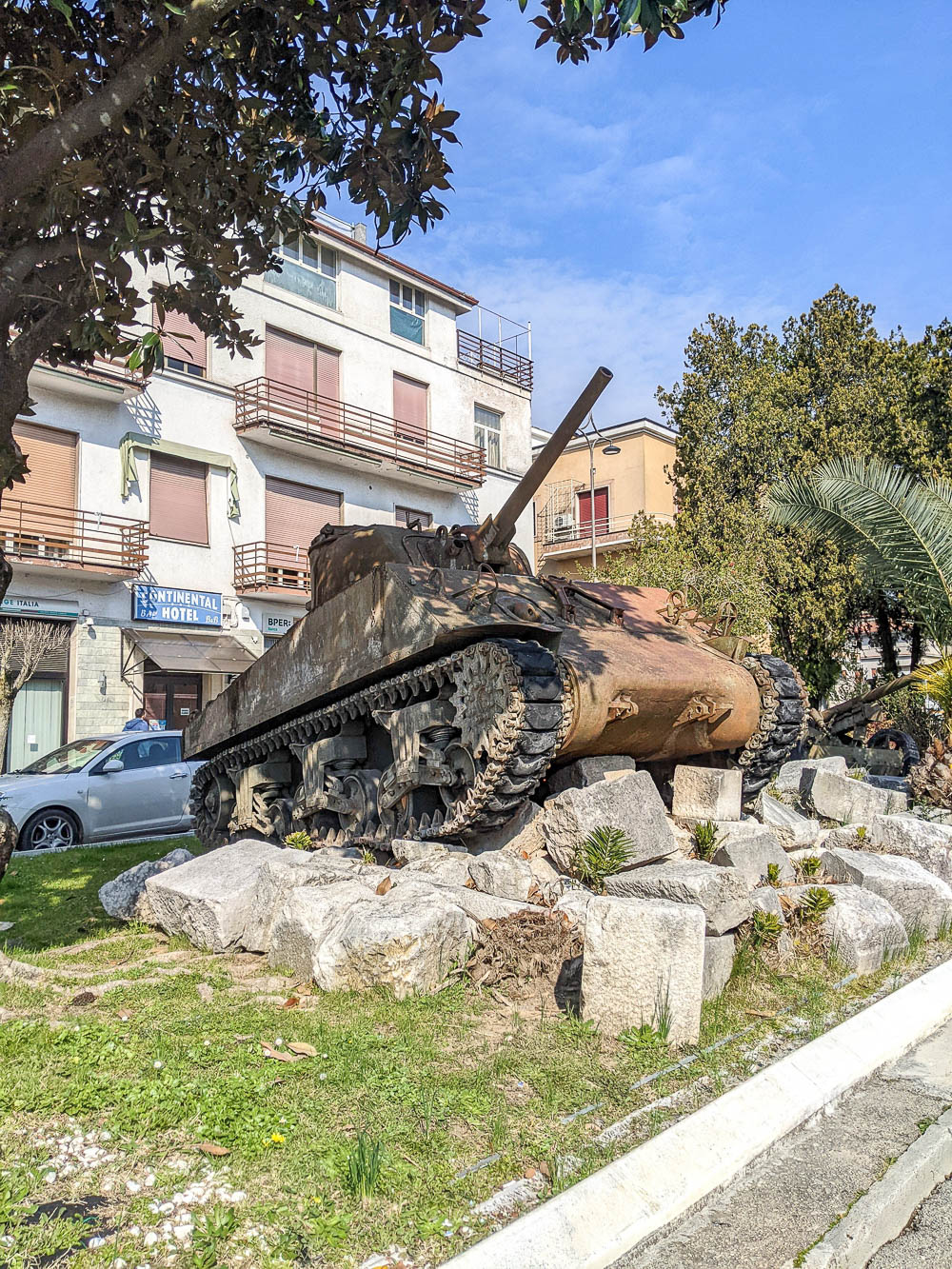
10. WWII history in Cassino town center
Back down in Cassino’s town center you’ll find a lot more World War II history to check out. Spend some time strolling the streets and see how much WWII history in Cassino you can sniff out.
For example, head over to Piazza Alcide de Gasperi where you’ll find the “Cassino City Memorial” which includes:
- a memorialized Sherman tank
- some war remnants and an anti-tank gun
- a couple of small memorials dedicated to residents of Cassino who were killed at Auschwitz
- a memorial honoring the fallen soldiers of the U.S. 34 th Infantry Division
- another commemorating the sacrifice of the city of Cassino during the war years
- and the long, descriptive, and visual Martyrology Wall that honors the 2,000 civilian residents who lost their lives.
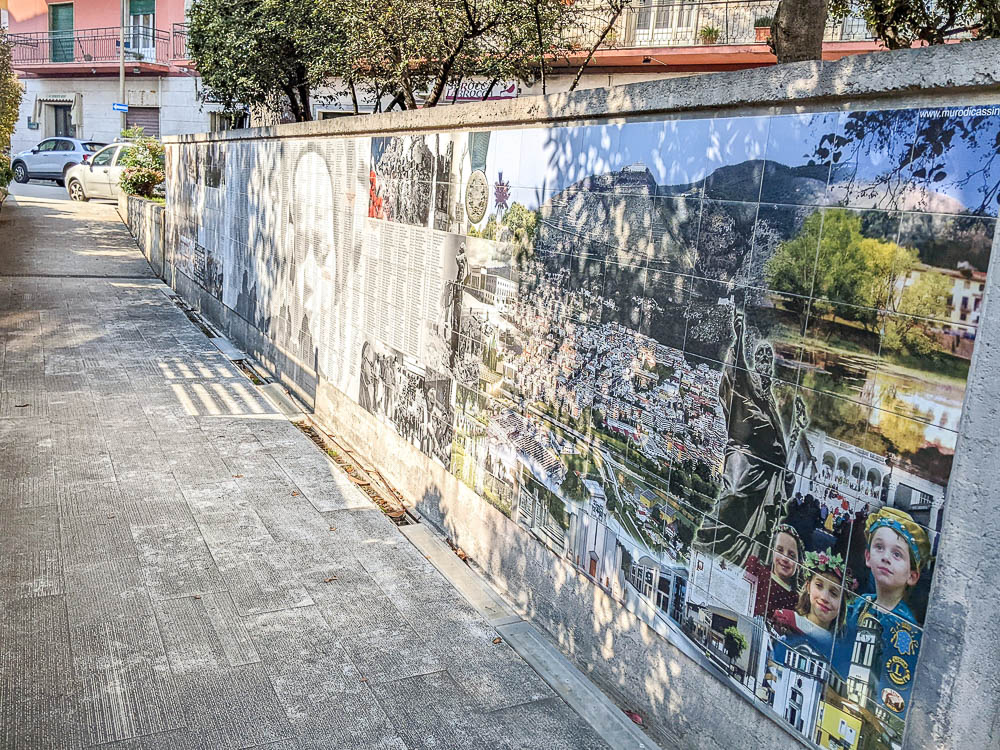
Where to stay when exploring WWII history in Cassino
During my visit to Cassino in March 2022, I stayed at the Hotel Piazza Marconi and wholeheartedly recommend it.
The location is perfect, parking is free, and the price is more than reasonable. Breakfast is included, the rooms are huge, and the staff is more than welcoming! I fully enjoyed my stay here. You can read more reviews here on Tripadvisor.
Book your stay here: Hotel Piazza Marconi
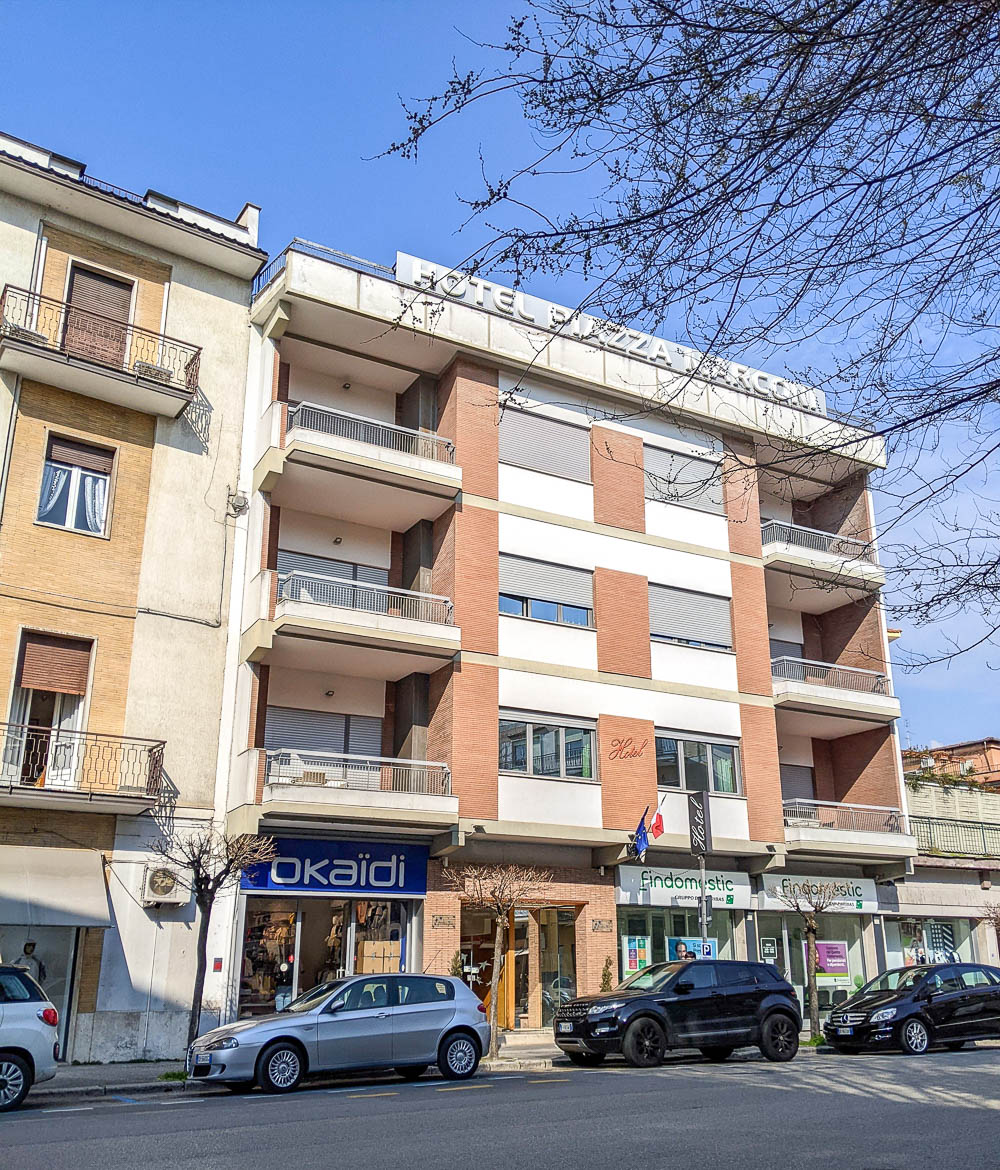
Besides Hotel Piazza Marconi, here are some other great Cassino accommodation options:
- Rainbow Suite – Weird name, but very highly rated hotel also near the town center
- Best Western Hotel Rocca – A little outside the center, but more high-end
- B&B Parini – A small but popular private guest house with great reviews
- All other Cassino options – There are a good number of options for where to stay during your visit to Cassino that include hotels, apartments, and more. Check them all out in that link to see which one works best for your trip.
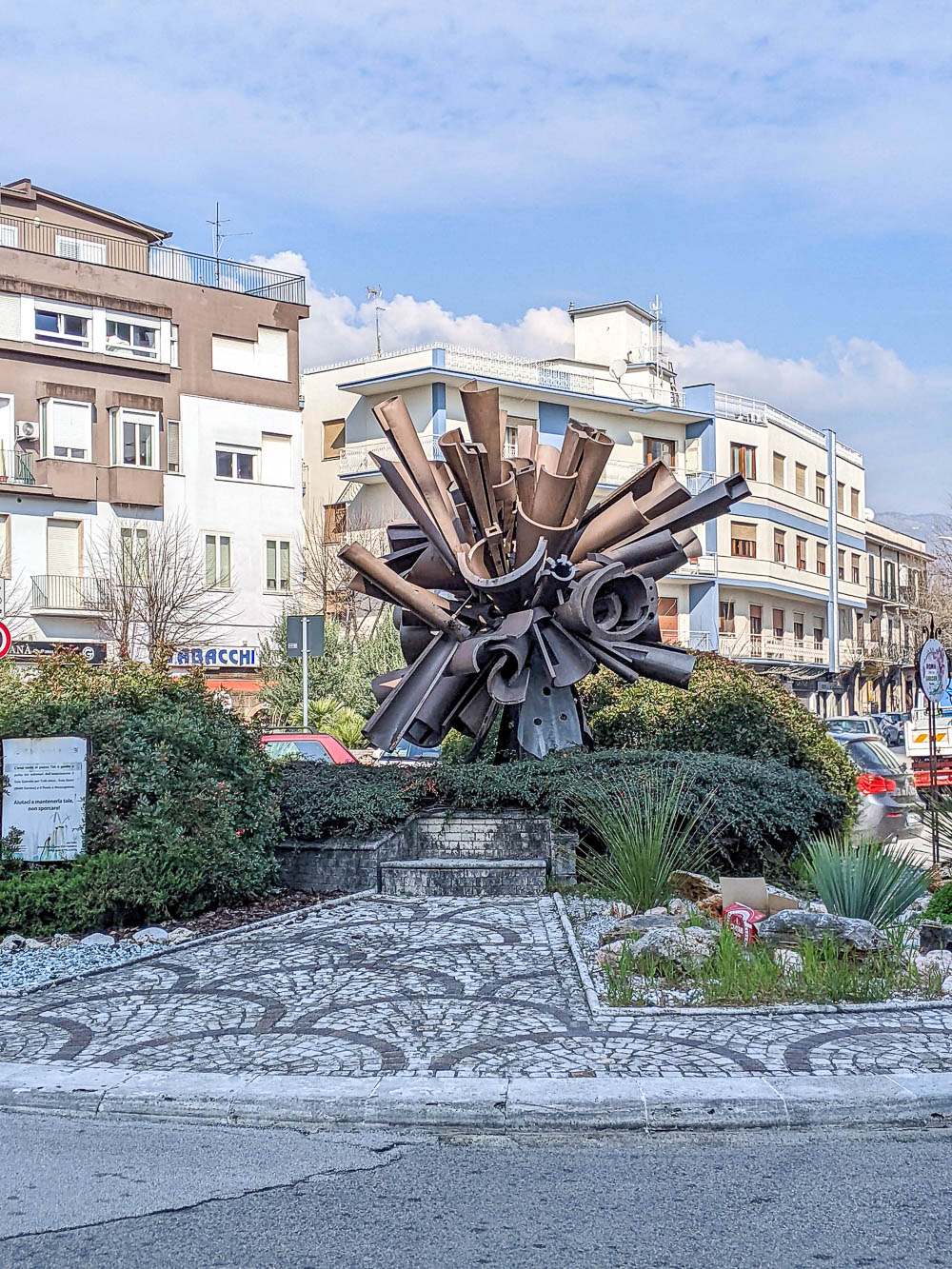
Books on WWII history in Cassino
Before your visit to Cassino, give these books a read to learn more about the WWII history in Cassino, its background, and the surrounding controversies:
- A Travel Guide to World War II Sites in Italy by Anne Leslie Saunders (2016) – Contains detailed lists of sites all over Italy with excellent historical background on each of them.
- Monte Cassino: The Hardest Fought Battle of World War II by Matthew Parker (2005)
- The Battles of Monte Cassino: The Campaign and Its Controversies by Glyn Harper and John Tonkin-Covell (2014)
- Monte Cassino: Ten Armies in Hell by Peter Caddick-Adams (2013)
- Monte Cassino: The Story of the Most Controversial Battle of World War II by David Hapgood and David Richardson (2002)
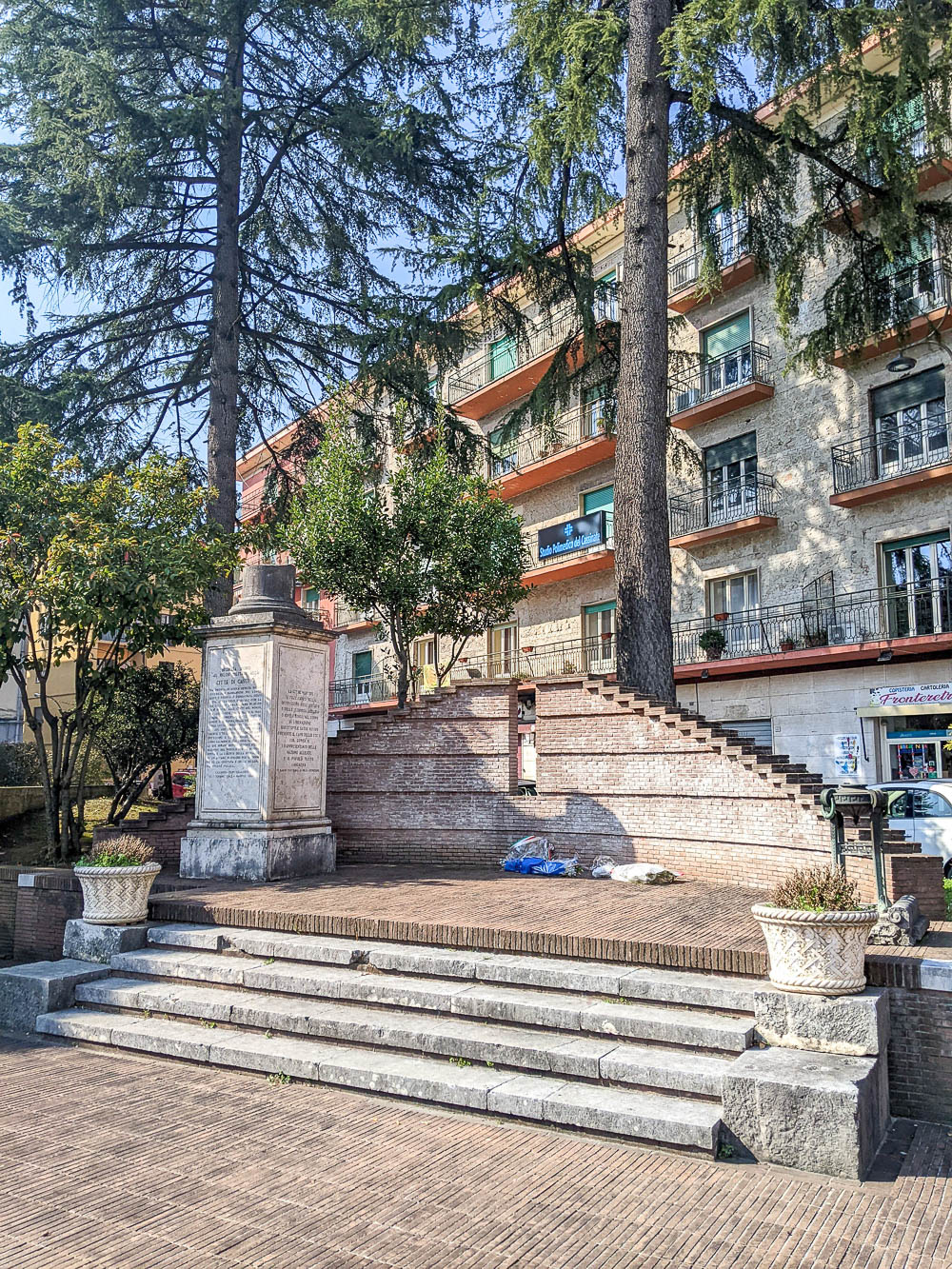
More info for your visit to Cassino
- Heading to Cassino? Read hotel reviews on Tripadvisor then book your room here !
- Need a rental car? Check out the best local rental car deals here .
- Pick up an Italy guidebook for all your Italy travels.
- And this Italy customs & culture guide is a must-pack item!
Save this info, pin this image:
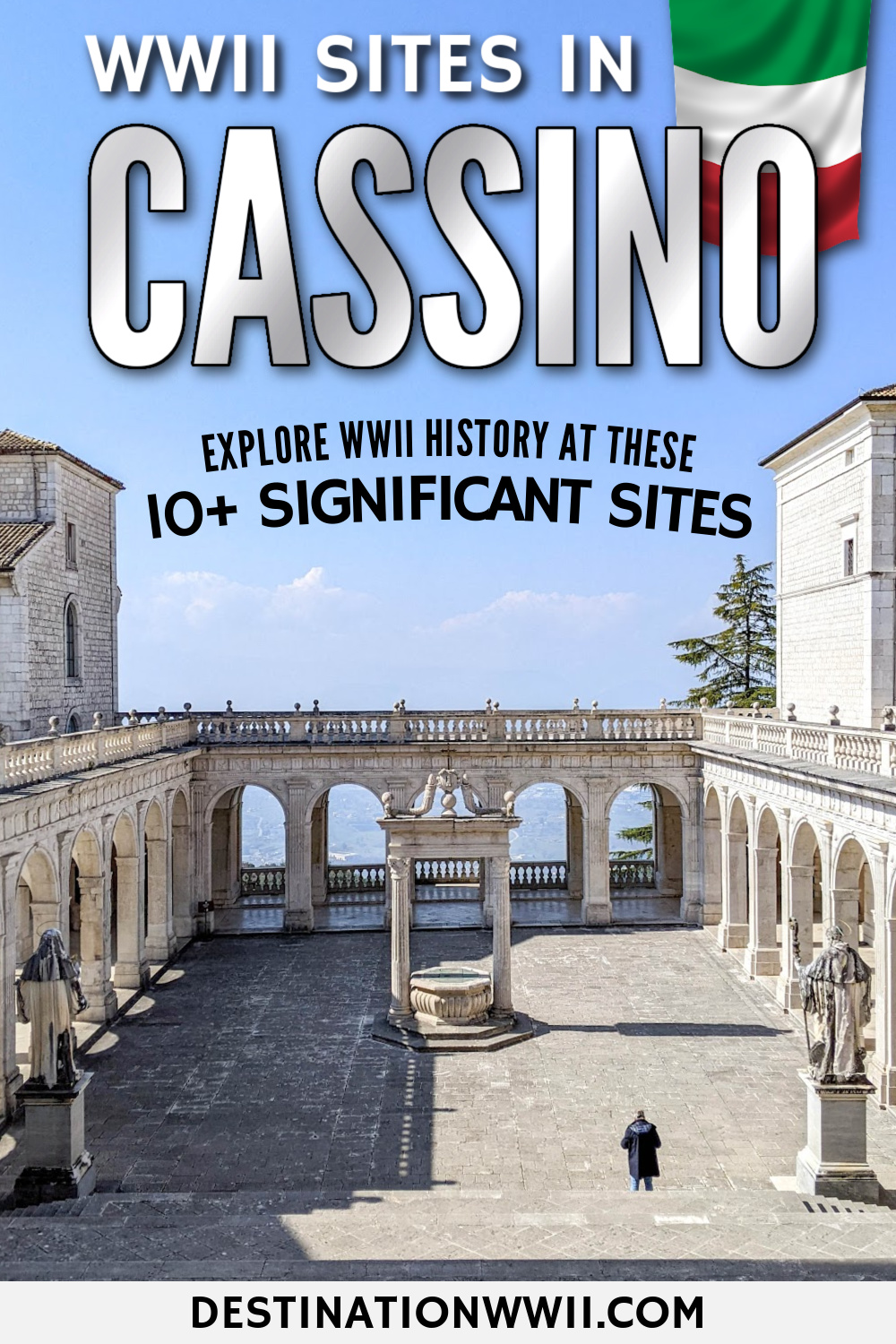
About Ashley Smith
Ashley is a World War II historian and travel expert who has visited 33 countries. She specializes in quick trips throughout Europe and the Americas with a focus on World War II museums, memorials, battlefields, and other sites of interest. Originally from Memphis, TN, she currently lives in Boston with her husband and two feline commanders.

Reader Interactions
Leave a reply cancel reply.
Your email address will not be published. Required fields are marked *

Paris WWII Sites Map
Three World War II Sites in Rome
With so much ancient history in Rome, few people associate the city with a war as recent as WWII. It is as if the thousand-year-old monuments and Roman ruins demand more attention than events that occurred while our grandparents were still alive. And that’s a shame. Not because we should linger on war, but must remember the oppression that lay in the wake and honour the victims of it – so it shall never happen again.
Some people travel to forget, but sometimes we must also travel to remember.
By Anne Leslie Saunders
These descriptions are based on my book, A Travel Guide to World War II Sites in Italy: Museums, Monuments, and Battlegrounds . It is sold by Amazon.com , Amazon.co.uk , Amazon.it and other online retailers.
Villa Torlonia
The stately nineteenth-century complex called Villa Torlonia was home to Mussolini and his family from 1925 to 1943, when the dictator was deposed. It features a palatial mansion and other buildings set in lush gardens on Via Nomentana, near the centre of Rome. Mussolini leased this villa for a small sum from a noble Roman family. Today, Romans and tourists enjoy the villa’s lovely landscape, the new restaurant with indoor/outdoor seating, and a children’s playground.
The city of Rome acquired Villa Torlonia in 1978 and has been restoring its buildings since then. The mansion (Casino Nobile) has several floors open to visitors. Frescoes, paintings, and statues adorn the mansion’s rooms. Some of the statues date back to the Roman Empire and were found on the estate during its restoration.
At Villa Torlonia Mussolini hosted important guests, including the emperor of Ethiopia, Haile Selassie, and Hitler himself. Due to wartime bombardments of Rome and other Italian cities, Mussolini had air raid shelters built on the property; visitors may tour those for an additional fee.
- Villa Torlonia website
- Villa Torlonia on Wikipedia
Jewish Museum and the Great Synagogue
The synagogue and museum make up a large building complex near the Tiber River in the centre of Rome. Throughout the day, the museum’s small theatre shows a film about Jewish life in Rome from 1870 to modern times; Italian and English versions of the film alternate. Included is the dreadful story of the arrest and deportation of Roman Jews to concentration camps during the war.
The arrests began in October 1943 in the neighbourhood around the synagogue. About one thousand Jews were placed in freight cars at a nearby train station and sent to a camp in Poland, where most deportees died. More deportations occurred in the following months, as the panels on the walls describe.
In addition to showing the film, the museum displays textiles, liturgical vessels, maps, books, and scrolls in large cases. Panels describe the artefacts, explain the basic tenets of Judaism, and review the history of the Jewish community in Rome. Visitors may also tour the synagogue, which was built in 1904 and is the largest of Rome’s twelve temples. Its splendid interior includes a dome painted in all colours of the rainbow.
After your tour, exit and look at the plaques posted on the synagogue’s walls. One lists the names of Jewish members of the Resistance who died fighting “Nazi-Fascist barbarism” and adds (in Italian): “Let their sacrifice be a warning to the oppressor and a model for the oppressed.” A second plaque commemorates the six million Jews who died in World War II. Its inscription says (in Italian): “These are not dry numbers, but a tribute of blood and tears in an injured civilization and an injury to the holy law of God.”
- Jewish Museum of Rome website
- Jewish Museum of Rome on Wikipedia
History Museum of the Liberation
This museum fills most of an apartment building on Via Tasso, a street near one of Rome’s grandest churches, St. John Lateran (San Giovanni Laterano). The museum’s modest façade gives no indication of the horrors that took place here in 1943 and 1944, when Rome was occupied by German forces. In the rooms that now form the museum, German police imprisoned, interrogated and tortured members of the Italian Resistance, whose goal was to free Italy from its Nazi-Fascist oppressors.
The first floor is devoted to temporary exhibits. The second floor has five rooms that formerly served as prison cells. Cell 2 is the size of a large closet and was used for solitary confinement. Messages scratched by prisoners are still visible on its walls. Examples are: “La morte è brutta per chi la teme” (Death is an evil for the person who fears it); “Medita o uomo sulla tua nullità di fronte alla grandezza dell’universo” (Man, meditate on your nothingness in comparison with the grandeur of the universe).
The third floor also has former prison cells. Prisoners’ drawings are still visible on the walls of a room used for solitary confinement, where one man scratched a British flag with the phrase “England Forever” on the flag’s base. Other rooms display wartime posters and underground newspapers produced by the Resistance.
- History Museum of the Liberation website
- History Museum of the Liberation on Wikipedia
These descriptions are based on my book, A Travel Guide to World War II Sites in Italy: Museums, Monuments, and Battlegrounds . It is sold by Amazon.com , Amazon.co.uk , Amazon.it and other online retailers.
For other guides to Rome, how about discovering the Eternal City on the Footsteps of Robert Langdon in our self-guided Angels And Demons tour or check out our tips for a Budget vs Luxury trip to Rome .
Discover more
Get under the skin of Rome by staying here a bit longer than just one week. We can strongly recommend Crib Med for medium-term rentals in the eternal city.

Learn more
Share this:.
- Click to share on Facebook (Opens in new window)
- Click to share on Twitter (Opens in new window)
- Click to share on Pinterest (Opens in new window)
Related posts

Unveiling the Charms of Calabria

Adventures in Northern Italy: Venice

Adventures in Northern Italy: Daytrip to Pisa
Got something to share we'd love to hear from you cancel reply.
- Privacy Policy
Five Lesser-known World War II Sites to Visit in Italy
History is always mesmerizing. We read about it in our school books. However, experiencing a war site is a whole new level of feeling and understanding history and how the world was shaped after WW II. So, let’s take a deeper look at some of the sites in Italy that are famous for WWII.
Basilica of San Lorenzo outside the Walls
World War II did not come without bombing and chaos. In 1943, around July to August, allied forces fought against the Germans in Sicily. The allied forces were constantly striking against the German force, and therefore, they damaged multiple factories and aimed to bombard and attack all enemy communication lines in Italy. But none of these came without casualties. Although the forces did not intend to attack civilians, they were seen as collateral damage and unintended targets of the bomb attacks.
Let’s say Italy during World War 2 was not as peaceful as it seems today. An example of striking the civilians was that Allies aimed to target Rome’s central rail yards. These were incredibly close to the Basilica of San Lorenzo and a cemetery. When the Allies attacked, the church and cemetery were damaged, along with the rail yards. Not only that, there were multiple injuries and casualties in the surrounding area.
- There are memorials to this event within Basilica;
- There is a mosaic that has replaced the original one that was destroyed;
- It contains Latin inscriptions about the tragedy, too. One of these inscriptions beautifully translates to “Give us peace in our time”;
- All these bombings in Rome led to the ultimate decision to imprison Mussolini;
- After six to seven weeks of the event, Italian forces withdrew their alliance with the Germans and surrendered.
You can buy already written essays about these historical events to help you out with classes and assignments if you find the information too overwhelming.

Museum of the Landing in Sicily
Have you ever heard about Operation Husky? Well, if you haven’t, it is the perfect opportunity to learn more about it. It was the code name for the Invasion of Sicily. The opposition wanted to invade and enter the island to easily make it to the mainlands.
There are many World War 2 battle sites in Italy, but this one is quite an action-packed one. The US Seventh and British Eighth, a common way to refer to army battalions, were sent to the island. If we want to know about the size of the attack, then it can be compared to the invasion of Normandy. Another information is that they were transported around several hundred miles of shoreline and eastern Sicily.
The event allowed future generations to view the exhibits and films within the museum. All these had a meaning: they told the current generations about the landing events and the battles that had taken place after it. It also spoke about the casualties that had taken place in that area. Italy World War II is something that you should read about because there is so much to it, and it is all quite fascinating!
Civitella in Val di Chiana: Memorials to a Massacre
While the German armies retreated to the north, the allied forces quickly liberated Rome in 1944. But that isn’t all there is to this event; the German forces faced strong attacks when retreating from the Italian Resistance. And guess why it had grown so much? Well, it was because of the release of Mussolini, of course!
We are sure you feel that it is a memorable WWII landing site in Italy, and it sure is, but the irony is that the country is full of such sites. So, how does Civitella become a site? Two partisans were quick to kill two German soldiers and injure the third one in a Civitella club around Arezzo without any surprise. Following this incident, the fear of life struck many residents, and they decided to move out of the area to avoid the same fate as the three soldiers.
After some time when nothing happened, the residents returned, thinking the danger was over. But sadly, there was more chaos to occur. German soldiers were back in 1944, on the 24 th of June. All the men in the city over the age of 15 were killed mercilessly as a sign of revenge. World War II Italy sure was bloody and messy!
Saint Paul’s Gate
The next turn of events occurred when Italians had surrendered to the allies. They were now pursuing to prevent German forces from taking over their lands. They did not have much success. Italy in WWII was an uncertain place. At Saint Paul’s Gate, Italian soldiers and civilians came together and always fought to keep German troops from entering Rome.
Italian men, women, and young boys would gather on rooftops and shoot at the German soldiers that flooded the streets. They kept resisting for as long as they could with strength and much courage. The clash was always deadly, and the German soldiers soon realized they needed to arm themselves. So, they came fully armed and fought against the Italians, who finally lost their stance, and many of them even lost their lives in the process. World War 2 in Italy showed that the Italians were capable individuals who never lost hope and tried their best to fight against oppression.
Rasella Street and the Ardeatine Graves
Rasella Street became pretty popular during Italy’s events in World War II. It so happened that certain members of the Italian resistance bombed the German soldiers in the street on the 23 rd of March, 1944.
The assault did not take place without a plan. Two partisans worked day and night to manufacture and attach a fuse to the bomb in a basement. Finally, they smartly put it in a trash cart, and a third partisan made sure the carriage entered the street by going into the Renaissance Palace called Palazzo Tittoni.
When German troops started marching up the street, one person lit the fuse and rushed away from it. The bomb exploded with vigor and killed at least 25 people in less than a minute. The remaining troops were shot, and the damage can still be seen on the buildings.
We are sure that you now understand why these sites are so commemorated and celebrated by the Italians. History is indeed something that we all must focus on. After all, it tells us a lot about the time before us. So, make sure you visit these sites related to the world conflict soon.
Related Images:
10 Best Italian Wars Books of All Time
Armir in the stalingrad campaign, you may also like, the “motozzattere”, the italian landing crafts of ww2, the battle of crete and the italian participation, refloating the battleships: the salvage of taranto, italian aa naval guns of ww2, italian naval camouflage in ww2, italian colonial troops, the end of the tunisian campaign, the battle of wadi akarit, the last axis offensives in tunisia (january-march 1943), the battle of mareth, 1943.
Advertisement
15 Must See World War II Sites in Europe
- Share Content on Facebook
- Share Content via Email
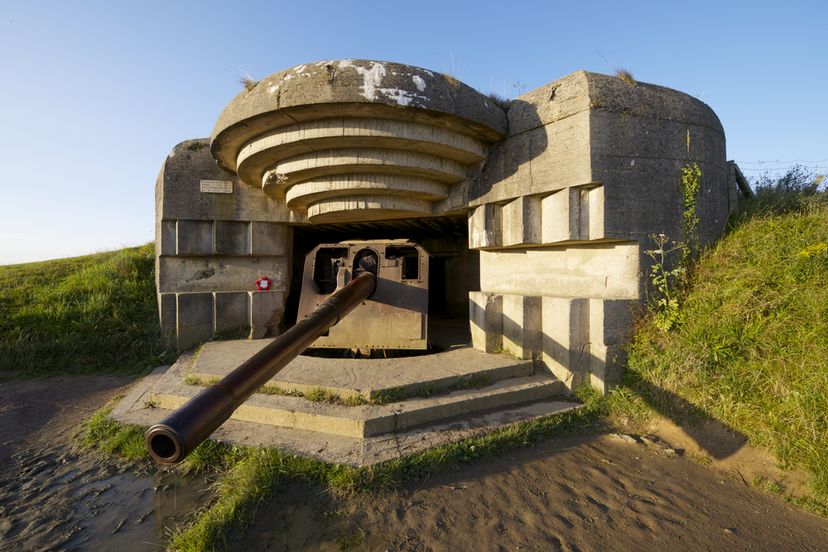
For those who are constantly glued to the World War II documentaries on the History Channel and have read countless books and articles about Allied tactics and strategic movements on the European fronts, a visit to Europe is the next step in your historical education. Personally seeing and physically standing on the many sites that were significant to that time will provide an unparalleled perspective and insight into the facts you already know about the war, as well as offer new information that is sometimes hard to come by from secondary sources. So for all the history buffs out there, here are 15 sites significant to the Second World War that, ranging from inspirational to overwhelming, are worth visiting in Europe:
15. Sachsenhausen Concentration Camp, Germany
This work camp just outside of Berlin is found about three km from the location of the first ever Nazi concentration camp known as Oranienburg (now destroyed). The camp became the center of Nazi operations and is now a museum detailing the life of the inhabitants, both officers and detainees in a number of exhibits. Visitors can also see the special exhibition dedicated to the Oranienburg camp found in the museum’s permanent exhibit, and walk the ground of the camp for an incomparable lesson in the severity of the Nazi aggression.
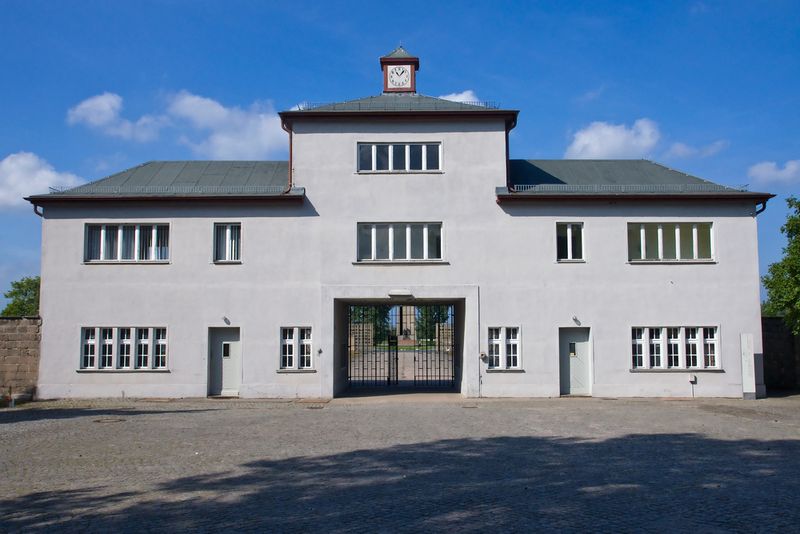
14. Arnhem Bridge, Netherlands
This bridge became well known after the strategic operation known as Operation Market Garden, whereby the Arnhem Bridge was the last in a string of strategic points targeted for takeover by the Allied forces. Successful up until that point, the Allies were unable to capture the bridge in the September 1944 Battle of Arnhem, an event that later became the subject of several books and the Hollywood film “A Bridge Too Far.” Surviving the September battle, the bridge was destroyed by Allied troops in October of the same year to help curb the transport of German supplies. In 1949 the bridge was rebuilt in the same style, and in 1977, renamed “The John Frostburg” in honor of the British commander that defended it in the September battle.
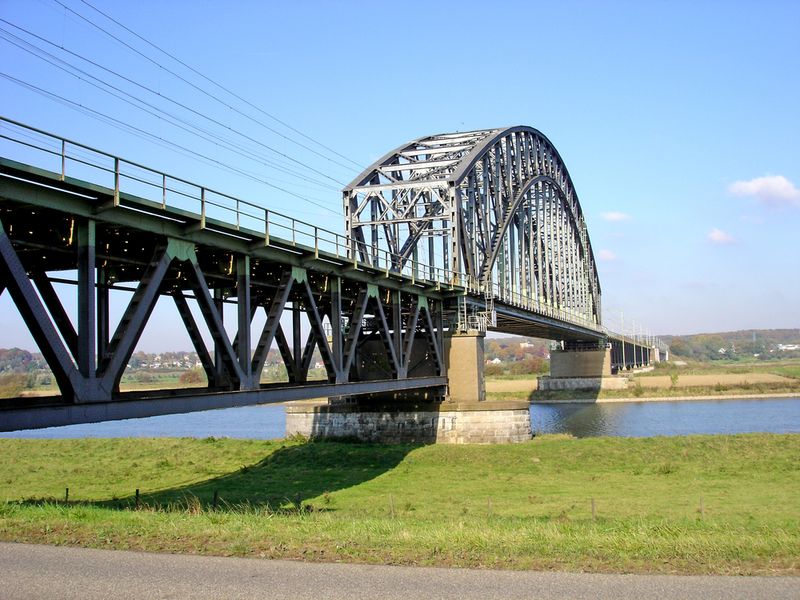
13. Oskar Schindler’s Enamel Factory, Krakow, Poland
As many who have read the Thomas Keneally’s novel “Schindler’s List” or seen the Spielberg movie of the same name know, Oskar Schindler was a Nazi Party member who saved hundreds of Jewish lives through political bribery and Jewish employment at his enamel and munitions factories. The administrative building of the enamel factory still stands today, and houses the Krakow Museum of Contemporary Art, as well as the Historical Museum of the City of Krakow, which is mainly devoted to the Party member and the lives of “his Jews.” This museum is must-see for anyone who wants to learn more about the life of a man now largely regarded as a hero.

12. Humboldthain Flak Tower, Germany
Originally constructed as a solution to air-strike vulnerability, German Flak Towers were domineering concrete complexes that sheltered anti-aircraft guns and protected ammunition from falling bombs. The towers operated in pairs, one a gun tower (Gefechsturm or G tower) and the other a command tower (Leitturn or L tower). Their heavily reinforced structure also served as bomb shelters for civilians as well as an extremely effective defensive center, with a radar dish that could detect bombers from over 50 miles away, eight 128-mm cannons with a firing capacity of 48 shells per minute and a number of other smaller cannons scattered around the tower. Many of the towers have since been destroyed or converted, but the one remaining in Berlin is open to visitors.
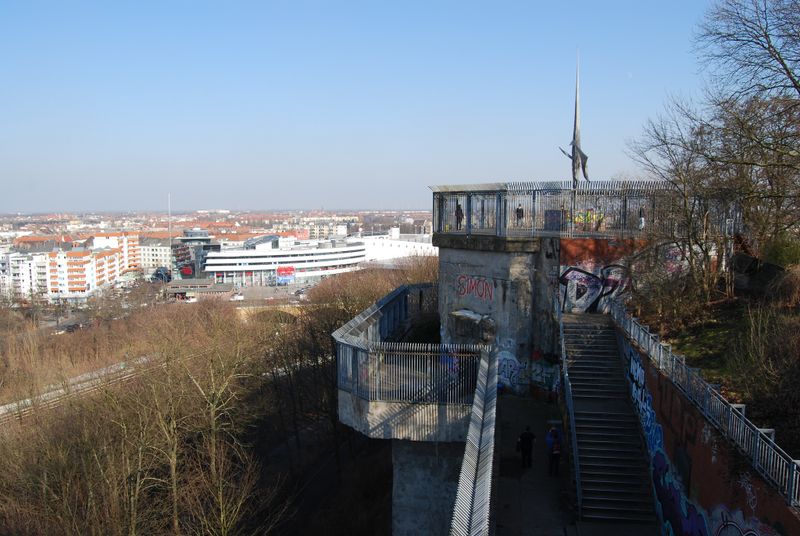
11. Vel D’Hiv Monument, France
Though the actual building of the Velodrome d’Hiver (indoor cycling track) was destroyed and replaced by government buildings, visitors can still stand on the spot, commemorated by a plaque, where in July of 1942, Jewish families in France were rounded up by the French police and forcibly herded into the Velodrome. It is there that over 13,000 citizens waited in deplorable conditions (without food, water or washroom facilities) for days before being dispersed among various concentration camps. A memorial to the victims was erected in the city in 1993, with the French Government issuing a public apology at a memorial service at the site in 1995.

10. Oradour-Sur-Glane, France
This small village in western France is memorialized as the site of one of the largest Nazi massacres on French soil. On June 10, 1944 SS officers stormed the village and killed the vast majority of residents, some 642 men, women and children, before largely destroying the area. Though officially rebuilt a few km north, the French government ordered the original site to be untouched and to stand testament to the horrors committed there. Visitors can walk through the ruins of the ghost town and pay their respects at the onsite memorial.
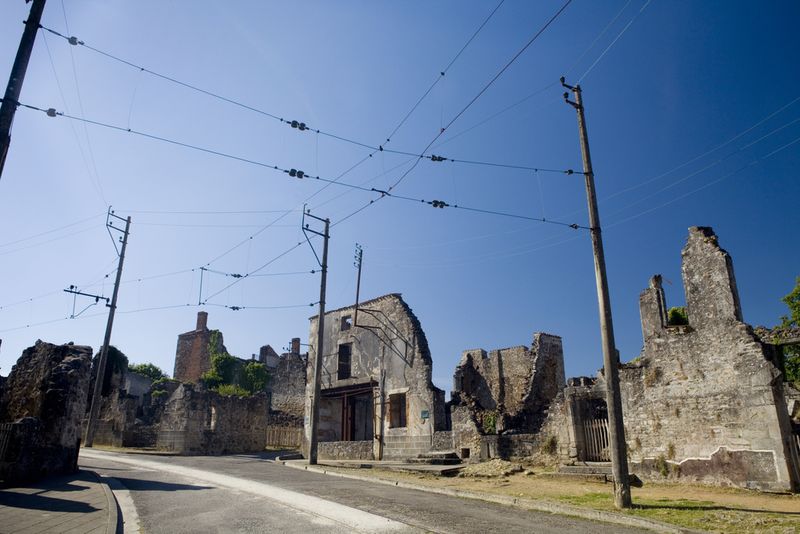
9. Umschlagplatz, Warsaw, Poland
During German occupation, the German-named Umschlagplatz (“reloading point”) was the Square in Warsaw used to round up Polish Jews and organize their deportation from the Ghetto to the Treblinka concentration camp. People waited in hordes for hours until enough detainees were rounded up to fill the train cars, with any signs of resistance resulting in instant death. Today, the site of the former Square is home to a memorial constructed in the image of train cars, erected to pay tribute to the countless lives doomed (and lost) on these very premises.

8. Warsaw Ghetto, Poland
In the beautiful Polish city of Warsaw, there still stands a testament to the largest and deadliest Nazi-created Ghetto in Europe. By the deadline of October 15, 1940, the city’s large Jewish population was forcibly required to move into an 18 km area which enclosed 73 of the city’s 1800 streets, and was divided into the “small” and “large” ghettos linked by a wooden bridge. At highest capacity, the Ghetto housed about 380,000 people, translating to about eight residents per room. Today, the site is commemorated by “The Footbridge of Memory” which denotes the location of the original bridge between the two Ghettos, several monument and memorials. The area also still contains chunks of the original separating wall as well as decrepit residential buildings which have stood untouched for the past seven decades.

7. The Wolf’s Lair, Poland
This major complex hidden among a dense Masurian forest was Hitler’s first headquarters on the Eastern Front, and became his most frequently inhabited hideout (he spent about half the war here). Originally built for the impending invasion of the Soviet Union, the property became a sort of small town consisting of shelters, barracks, two airfields as well as a power and rail station. Despite being heavily reinforced and highly secure, this was also the site of the infamous July 1944 assassination attempt of Hitler by Claus Von Stauffenberg. The premises were vacated and destroyed by German officials in January of 1945 and remained untouched by the Polish Government until the fall of Communism. Today, the site is in ruins but has become a popular tourist attraction with a handful of hotels and restaurants now available in the remote area.

6. Bletchley Park, England
Featured in the film “The Imitation Game,” Bletchley Park in Buckinghamshire was Britain’s central site for code breaking during the Second World War. As the location of the Government Code and Cypher School (GC&CS), it became the largest and most successful institution in penetrating secret Axis communications, most famously of the German Enigma and Lorenz ciphers. Analysis now suggests that the efforts conducted on these premises shortened the war by about 2 years, and the school is now an educational and historic attraction commemorating the accomplishments of the institution.

5. Fuhrerbunker, Berlin
Now largely destroyed, this bunker was located under the former Reich Chancellery building in the heart of the city, and is the site where Hitler spent the last few weeks of the war, married Eva Braun and committed suicide in April of 1945. Located 11.5 feet below ground level, the bunker was a system of 30 small rooms protected by 13 foot thick concrete walls with an exit point in the Reich Chancellery gardens. Today, the site looks inconspicuous enough as a quiet residential neighborhood, and is largely unmarked save the small plaque and information board that denotes the location and provides a schematic diagram of the bunker.
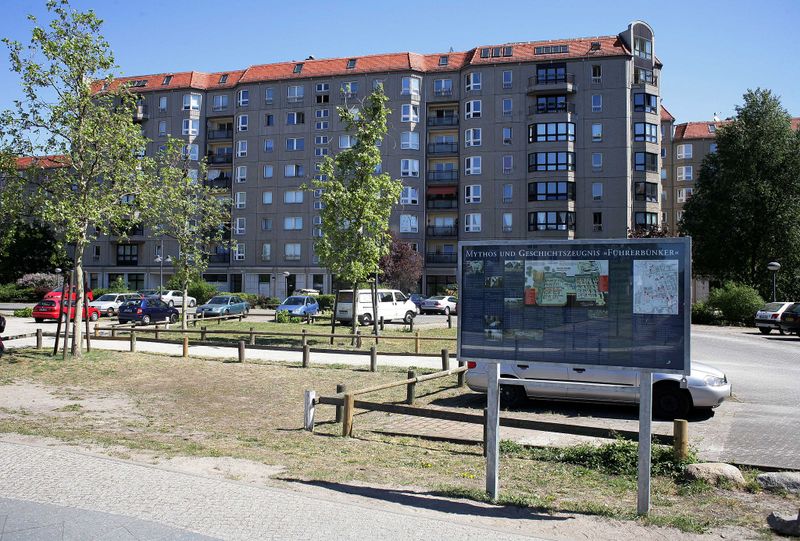
4. Cabinet War Rooms, England
Partially restored and opened as a museum to the public in 1985, the Cabinet War Rooms were originally a secret complex under the basement of the Treasury. The bomb blitz of December 1940 forced the complex to be reinforced as a bomb bunker, becoming the main strategic headquarters for the War Cabinet (consisting of Prime Minister Churchill and several Conservative and Labor Party ministers). Today visitors can descend below the streets of Westminster and check out the various rooms of the complex as they would have existed during the war, and of especial significance, the Map Room, which remains exactly as it was when the premises were closed and vacated in August of 1945.
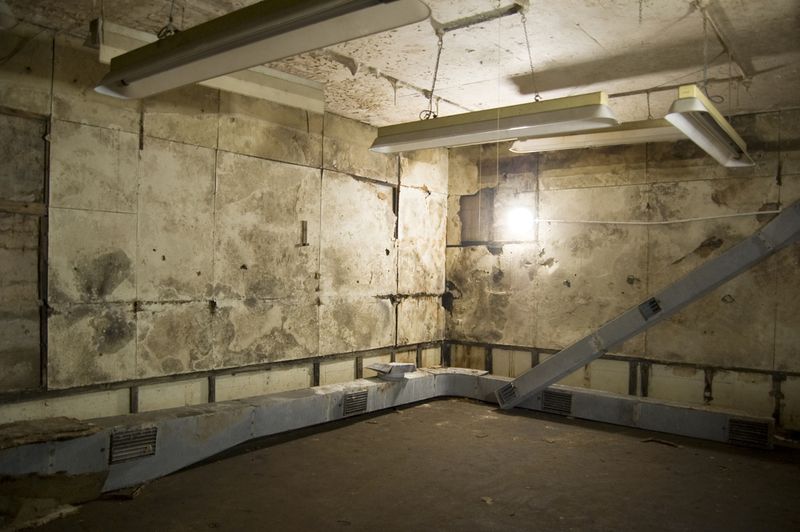
3. Auschwitz- Birkenau, Poland
Originally built in 1940 as a detention center for political prisoners, Auschwitz-Birkenau became the Nazi’s most gruesome legacy—the largest death camp and the primary site for the “Final Solution.” Located on the site of a former military base just outside of Krakow, Poland, the complex was regarded as the ideal location to carry out Nazi atrocities because of its proximity to the rail lines used to transport prisoners. Liberated on January 27, 1945 by the Soviet Army, estimates suggest that upwards of 1.1 million deaths were carried out on the property. Today, Auschwitz is a harrowing museum complex not for the faint of heart. While undeniably an important site to see, visitors are urged to check out the museum website ( http://visit.auschwitz.org/ ) to familiarize themselves with the rules, entry pass guidelines and capacity restrictions before their visit.
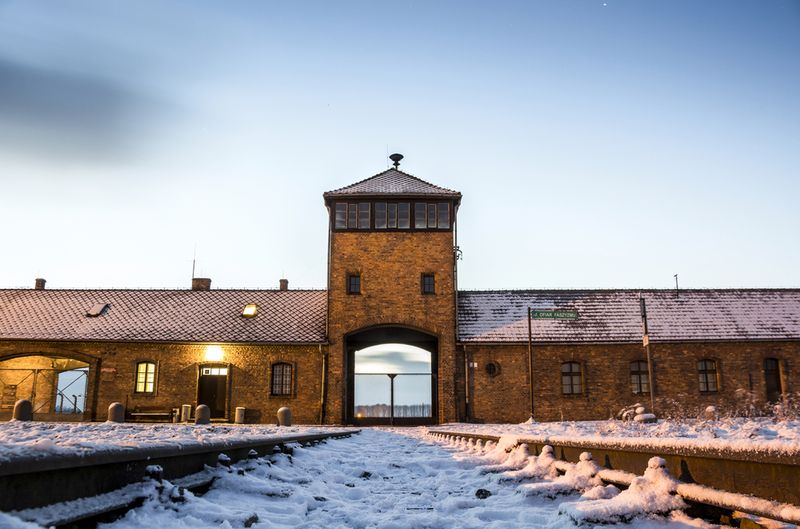
2. Musee de la Reddition, France
This red brick schoolhouse just northwest of the Reims train station is the historic site where, in the early morning of May 7, 1945 high officers from the German army met with officers of the Allied forces and signed the declaration of unconditional surrender, ending the second world war in Europe. Now known as the Lycee Roosevelt, the property was being used as the headquarters of Supreme Allied Commander in Europe, General Dwight D. Eisenhower, and the room where the signature took place, the map room, remains perfectly preserved behind a glass panel and comprises the museum now called the Musee de la Reddition.

1. Normandy, France
It is on this stretch of beaches on the Normandy coast where the infamous D-Day Landings of June 6, 1944 took place, changing the course of the war to favor the Allies. The five beaches—Sword, Juno, Gold, Omaha and Utah—were where the forces of the French, British, Canadian and American armies successfully landed and commenced an operation that changed the tide of WWII in Europe. Today, visitors can pay their respects to the sacrifices made by these troops at the various memorials found on the beaches, at the military cemeteries of each army and learn more about the operation and strategy at the various museums and information centers.

Like this? Check out 10 Significant World War II Sites to Visit in Germany
Please copy/paste the following text to properly cite this HowStuffWorks.com article:
- Outdoor Activities
- Destinations
- Book Hotels, Flights & Cars
- Advertise With Us
- Cookie Settings
Copyright © 2024 MapQuest Holdings LLC, a System1 Company

Special offer
Wwii sicily landing beaches and battlefield tour.
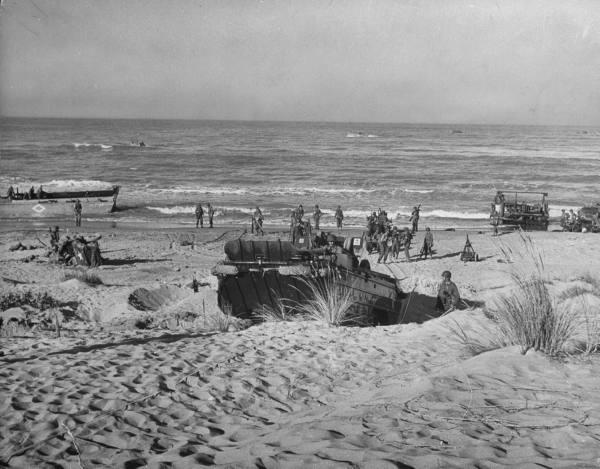
Visit the WWII Sicily landing beaches and the battlefields that marked the beginning of the Husky Operation
Brush up on history and retrace the events of the very first days of the invasion of sicily with an expert.
Since ancient times the area around Licata and Gela has landed a role in world military history. Off its the coast, in 256, the fleets of Rome and Carthage fought one of the largest (perhaps the largest) naval battles in history during the First Punic War (“The War for Sicily”). The same waters, on the night of 10 July 1943, were the scene of the first and largest amphibious operation of WWII: the Landing in Sicily (codenamed “Operation Husky”).
The tour will take you to Licata, Gela , the beaches, and the many significant sites that were the first portions of Axis territory hit by the American army in WWII. Our expert historian will make you re-live those crucial days in the Second World War. Whilst traveling in a scenery of compelling beauty you’ll see for yourself the difficulties posed by the terrain for both the attackers and the defenders. The visit to bunkers and an air-raid shelter will shed light on the perilous daily life of soldiers and civilians. With the help of our expert historian/ guide, you’ll learn about the events that preceded and followed the landing and made George Patton win the “Race to Messina” .
WII Sicily Landing Tour Higlighlights
- Licata landing beach and air-shelter
- Gela landing beach and battlefield
- Dirillo bridge and war-memorial
WII Sicily Landing Tour Description
In the morning we drive to Licata , the first town of the “Fortress Europe” that was conquered by the Allied Forces in the morning of 10 July 1943. Along the way, our expert historian will discuss the events that preceded the landing and the strategy of the US landings. Stop at the Mollarella beach and then walk in Licata’s city centre. We’ll see the Town Hall, visit the small Landing Museum and an air-raid shelter from WWII. Lunch in Licata In the afternoon, we continue to Gela to see the beach of Patton’s landing . Here, you’ll learn about the 3 Infantry Division’s and 45 Infantry Division’s amphibious assaults and the Italian and German counterattacks. Our last stop will be at the Italian bunker complex, near Ponte Dirillo and overlooked by the Biazza Ridge, where you can still see the marks of fierce fighting. In this area, Colonel James Gavin and 82nd Airborne Division held their position against the overwhelming forces of the Hermann Goering Division.
Booking/Enquiries
Email address
Terms and Conditions Terms and Conditions I agree with privacy Terms and Conditions
Booking/Enquiry
E-mail address
Related products
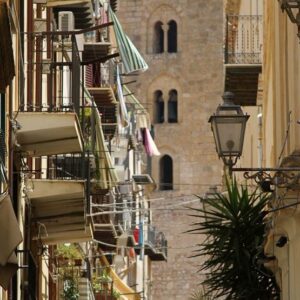
Cefalu Tour 2024

Monreale Tour 2024

The Authentic Sicilian Olive oil Experience 2023

Palermo Street Food Tour 2024

Enjoy fast, free delivery, exclusive deals, and award-winning movies & TV shows with Prime Try Prime and start saving today with fast, free delivery
Amazon Prime includes:
Fast, FREE Delivery is available to Prime members. To join, select "Try Amazon Prime and start saving today with Fast, FREE Delivery" below the Add to Cart button.
- Cardmembers earn 5% Back at Amazon.com with a Prime Credit Card.
- Unlimited Free Two-Day Delivery
- Streaming of thousands of movies and TV shows with limited ads on Prime Video.
- A Kindle book to borrow for free each month - with no due dates
- Listen to over 2 million songs and hundreds of playlists
- Unlimited photo storage with anywhere access
Important: Your credit card will NOT be charged when you start your free trial or if you cancel during the trial period. If you're happy with Amazon Prime, do nothing. At the end of the free trial, your membership will automatically upgrade to a monthly membership.
Buy new: $8.99 $8.99 FREE delivery: Thursday, April 25 on orders over $35.00 shipped by Amazon. Ships from: Amazon.com Sold by: Amazon.com
Return this item for free.
Free returns are available for the shipping address you chose. You can return the item for any reason in new and unused condition: no shipping charges
- Go to your orders and start the return
- Select the return method
Buy used: $4.99

Download the free Kindle app and start reading Kindle books instantly on your smartphone, tablet, or computer - no Kindle device required .
Read instantly on your browser with Kindle for Web.
Using your mobile phone camera - scan the code below and download the Kindle app.

Image Unavailable

- To view this video download Flash Player
Follow the author

A Travel Guide to World War II Sites in Italy: Museums, Monuments, and Battlegrounds Paperback – December 13, 2016
Purchase options and add-ons.
- Print length 188 pages
- Language English
- Publication date December 13, 2016
- Dimensions 6 x 0.43 x 9 inches
- ISBN-10 1540566048
- ISBN-13 978-1540566041
- See all details

Frequently bought together

Similar items that may deliver to you quickly

Editorial Reviews
From the author, about the author, product details.
- Publisher : CreateSpace Independent Publishing Platform; 2nd edition (December 13, 2016)
- Language : English
- Paperback : 188 pages
- ISBN-10 : 1540566048
- ISBN-13 : 978-1540566041
- Item Weight : 9.1 ounces
- Dimensions : 6 x 0.43 x 9 inches
- #1,173 in general Italy Travel Guides
- #7,839 in World War II History (Books)
About the author
Anne leslie saunders.
Author Anne Saunders is a research associate at the College of Charleston in South Carolina (USA). In 2016 she published the second edition of a guidebook that describes 200 WWII memorial sites in Italy. These sites are grouped into 19 tours that begin in Sicily and follow the armies north toward Bologna and Trieste. For each site the author provides an address, GPS coordinates, and additional directions as needed. Readers can use that information to create their own maps by plugging addresses etc. into Google Maps (or a similar app) on their cell phone, tablet or computer.
Customer reviews
Customer Reviews, including Product Star Ratings help customers to learn more about the product and decide whether it is the right product for them.
To calculate the overall star rating and percentage breakdown by star, we don’t use a simple average. Instead, our system considers things like how recent a review is and if the reviewer bought the item on Amazon. It also analyzed reviews to verify trustworthiness.
- Sort reviews by Top reviews Most recent Top reviews
Top reviews from the United States
There was a problem filtering reviews right now. please try again later..
Top reviews from other countries
- Amazon Newsletter
- About Amazon
- Accessibility
- Sustainability
- Press Center
- Investor Relations
- Amazon Devices
- Amazon Science
- Sell on Amazon
- Sell apps on Amazon
- Supply to Amazon
- Protect & Build Your Brand
- Become an Affiliate
- Become a Delivery Driver
- Start a Package Delivery Business
- Advertise Your Products
- Self-Publish with Us
- Become an Amazon Hub Partner
- › See More Ways to Make Money
- Amazon Visa
- Amazon Store Card
- Amazon Secured Card
- Amazon Business Card
- Shop with Points
- Credit Card Marketplace
- Reload Your Balance
- Amazon Currency Converter
- Your Account
- Your Orders
- Shipping Rates & Policies
- Amazon Prime
- Returns & Replacements
- Manage Your Content and Devices
- Recalls and Product Safety Alerts
- Conditions of Use
- Privacy Notice
- Consumer Health Data Privacy Disclosure
- Your Ads Privacy Choices
Rated 98% based on 1028 reviews

UK 0345 475 1815 USA (toll free) 877‑209‑5620 International 00 44 345 475 1815 [email protected] Rated 98% on feefo
Sign-in Latest News Subscribe Request Brochure
- Future Planning
- Military History and Battlefield Tours
- Classical History and Archaeological Tours
- Holocaust Tours
- General History Tours
- Experience Tours
- Walking Tours
- Early Periods
- 17th & 18th Century
- Victorian Era
- First World War
- Second World War
- Cross-Periods
- Destinations
- Our Expert Historians
- Historians Q&A
- Historical Tailor Made Tours
- School Tours
- Battlefield Studies
- Testimonials
- What to Expect
- Activity Levels
- Tour Diaries & Images
- Our Library
- Frequently Asked Questions
- Work For TCE
- General Booking Conditions
- Download Booking Form
- Tours by Date
- Tours by Theme
- Tours by Period
- Tours by Destination
- Latest News
- Request Brochure

Anzio & Cassino 1944
Breaching the gustav line.
Military History and Battlefield Tours
To be confirmed
click here to register your interest
Your Holiday Essentials
Tour introduction.
This tour is simply compelling. Your tour leader, Patrick Mercer, is the son of one of those who fought here and he spent much of his youth interviewing his father’s comrades. As such, his narrative is studded with personal stories and you will stand on the ground where men struggled, bled and died. Indeed, the evidence in this part of Italy is all around you. Dugouts, trenches, stone sangars, bunkers and tank turrets are all there to be seen - and in your expert historian you will have someone who knows exactly where to find, having walked and scrambled over this ground dozens of times.
Accordingly, the tour will traverse the mountains, rivers and streams of Cassino and central Italy right down to the coastal plain and dried up tributaries of the Molleta River north of Anzio - the infamous ‘Wadis’. Breathtakingly, we will finish in the Alban Hills at Nemi, close to the Pope’s summer palace - an idyllic spot from which German observers could see right down to the coast and Allied shipping.
After the bloodbath of Salerno and then the torture of the Volturno crossings, the US and British troops of Mark Clark’s 5th Army has to deal with the Axis Forces on the so-called Winter Line. At Camino and San Pietro the Tommies and Yanks battered their way through their enemies only to find Kesselring’s men firmly ensconced on the Gustav Line, anchored on the louring monastery of Cassino.
The epic battles to crack through the defences that lined the Garigliano River dwarfed anything that the Allies had experienced in Italy up until then. Then, spearheaded by Free French, Canadians and Poles, the offensive still had to sunder the Hitler Line before the road to Rome was clear.
Few people understand that the landings at Anzio were a daring, amphibious hook around the Gustav Line. Had they worked, had they been properly directed, the gallant German defence must have crumbled. In the event, the landings almost failed bloodily and it was only by 8th Army’s being brought to 5th Army’s help that victory was achieved.
- With retired Army Colonel Patrick Mercer OBE
- The Four Battles for Cassino
- The Anzio Landings
- The picturesque ruins of San Pietro
Day 1 - San Pietro
Fly London to Rome and head to San Pietro. Having talked through the origins of the campaign and the combat leading up to the winter of 1943, you will be shown around the picturesque ruins of the village itself. Check in to our Cassino hotel for four nights.
Day 2 - Approach to Cassino
The battles of the Winter Line are hardly understood, yet they were bloody and bitter. There should have been no pause at Christmas time, but General Clark allowed his exhausted troops to lick their wounds before closing in on the Garigliano and Cassino. First, we will see how the Guards and 56th Division took Camino. Then how the US 36th Division fought three battles for San Pietro before they failed to cross the Rapido - and the controversy that surrounded it.
Day 3 - The Lower Garigliano
Continuing the theme of the first attempt to cross the rivers whilst under the eyes of Cassino, we will examine both the British failures and successes on the Lower Garigliano. First, 128 (Hampshire) Brigade’s doomed crossings near Rocco D’Evandro before we study 56 (London) Division’s storming success at Castleforte and the shocking fighting for Damiano Ridge where Pte Mitchell of 1st Bn London Scottish won a VC. The day will culminate at Minturno CWGC Cemetery near where 5 (Yorkshire) Div crossed the Garigliano and, as an added extra, the Bourbon Bridge and Count Bayard’s exploits in 1503.
Day 4 - Battles for Cassino
Today is concentrated around Cassino. First, we will examine the decision to bomb the monastery whilst looking at its opulent replacement. The New Zealanders’ fighting for the town of Cassino will follow, then the Polish thrust for the heights above the town. To finish the day, we will see the joint US and French flanking attack to the south of the Liri Valley before the main operation - Diadem - in May 44 to break through the Germans’ resistance. Fittingly, we will pay our respects at the Cassino CWGC as a prelude to the next day.
Day 5 - Break out & Hitler Line
No account of the fighting around Cassino is complete without the Canadians’ and Free French epilogue between the towns of Pontecorvo and Aquino. The cracking of the bristling Hitler Line was a minor epic and the remains of the concrete bunkers and tank turrets which the Germans used can still be seen. From there, we will drive to the Anzio Beachhead stopping to examine the US Rangers’ attack on the Mussolini Canal and 3rd Inf Div’s bloody fight at Isola Bella and its bold assault on Cisterna in January 1944. Check-in to our Nettuno hotel for two nights.
Day 6 - Anzio
Our penultimate day will start at Anzio and the landings there before we drive inland to Campoleone to see how 46 RTR, the Guards and 2nd Sherwood Foresters - as well as many other units - came within a whisker of capturing the town and rupturing the German line of communication down to Cassino and the Gustav Line. The mayhem at Aprilia and the Flyover before the German counter-attack was stemmed will be studied before we do what few other groups do. The ‘wadis’ fighting of Feb - May 44 epitomises Anzio yet few other guides go there and when they do they get lost! But we’ll do it and feel the atmosphere of fighting which many Germans thought was worse than Stalingrad or Sebastopol.
Day 7 - Overview
On our last morning we will drive up to the Alban Hills and the bijou village of Nemi where Lord Byron wrote Childe Harold. In 1944, though, it was altogether a more sinister place as the Germans used it for their artillery observers. In this wonderful eyrie, Patrick will sum up the events of those crucial months below Rome. Return flight to London.
Recommended Reading List
- Monte Casino - Ten Armies in Hell
- The Second World War: A Military History
Photo Gallery
- View across wadi from German position
- The group at the top of Camino overlooking the valleys
- Nemi village
- Monte Cassino from Castle Hill
- View of the Abbey
- Lago di Nemi
- Sicily-Rome American Cemetery
- Inside the monastery walls
- View over the lake from Nemi, a critical German observation point
Tour Review
Take a look at some of the images taken on our most recent tour

direct link
Subscribe to Our E-Newsletter
For up to date news as well as details about all of our tours please subscribe to our fortnightly e-newsletter

Quick Links
Military History and Battlefield Tours Classical History and Archaeological Tours Holocaust Tours General History Tours Experience Tours Walking Tours Future Planning Request Brochure Site Map
The Cultural Experience 11B Mansfield Park Four Marks Alton GU34 5PZ United Kingdom
UK: 0345 475 1815 USA (toll free): 877 209 5620 International: 00 44 345 475 1815
© 2015 - 2024 Midas Tours Ltd - Hosted by SWD - Legal Info - Terms of Use - Privacy Policy / Cookies - Sign-in
- Italy Tourism
- Italy Hotels
- Italy Bed and Breakfast
- Italy Vacation Rentals
- Flights to Italy
- Italy Restaurants
- Things to Do in Italy
- Italy Travel Forum
- Italy Photos
- All Italy Hotels
- Italy Hotel Deals
- Last Minute Hotels in Italy
- Things to Do
- Restaurants
- Vacation Rentals
- Travel Stories
- Rental Cars
- Add a Place
- Travel Forum
- Travelers' Choice
- Help Center
WOrld War II Sights - Italy Forum
- Europe
- Italy
WOrld War II Sights
- United States Forums
- Europe Forums
- Canada Forums
- Asia Forums
- Central America Forums
- Africa Forums
- Caribbean Forums
- Mexico Forums
- South Pacific Forums
- South America Forums
- Middle East Forums
- Honeymoons and Romance
- Business Travel
- Train Travel
- Traveling With Disabilities
- Tripadvisor Support
- Solo Travel
- Bargain Travel
- Timeshares / Vacation Rentals
- Europe forums
- Italy forum

Check out: http://www.officine.it/montecassino/main_e.htm

The Commonwealth War Graves Commission has a list of cemeteries and memorials which includes several where Canadian dead are buried - that can be found here:
http://www.cwgc.org/admin/files/Italy.pdf
A short way north of Rome, there are Italian and other WWII aircraft amongst the collection of the 'Museo storico dell'Aeronautica Militare' at Vigna di Valle, on the shore of the lake - just a mile or two south of the town of Bracciano - which makes for a pleasant day's outing.
http://www.pbase.com/isolaverde/ostia_bracc
There's a museum which preserves a variety of relics that have found at the Anzio Beachhead over the years, here:
http://www.sbarcodianzio.it/english.htm
You'll find little evidence now but the Royal Palace at Caserta - about 15 miles outside Naples - was the Allied HQ for a while, and a major hospital and recuperation centre for a lot longer, and it was there that the unconditional surrender was signed in April 1945.
http://www.pbase.com/isolaverde/caserta
Further south still, the city of Salerno has undergone extensive reconstruction, and today both it and Naples very little sign of the damage they suffered.
Other than that, I recollect there being a touching memorial to the Holocaust in the Venice ghetto..
Thank you both for the help. I will do some investigating on these websites.
Thanks again, Peter
http://www.battlefieldsww2.50megs.com/italy.htm

http://www.tripadvisor.com/ShowTopic-g187870-i57-k2234475-Jewish_Ghetto_in_Venice-Venice_Veneto.html
Since you're in Vermont, I assume you're interested in American participation in World War II.
http://www.abmc.gov/cemeteries/cemeteries/sr.php
There is also an American war cemetery near Florence :
http://www.abmc.gov/cemeteries/cemeteries/fl.php
e-mail to: [email protected]
or call them at +44 (0) 1628 507200, they do publish a guide with maps and the briefest possible history of the Italian Campaign.
Their work speaks to me more than battlefields.
excuse me, that should show cwgc.org

timetables of more than one hundred sites from Cassino (south of ROme ) to Trieste, including locations near Florence and Bologna .
This topic has been closed to new posts due to inactivity.
- Air condition in summer - July 4:14 pm
- Trastevere 4:14 pm
- Bus, ferry, and rental car 4:11 pm
- Train tickets to be validated before boarding ? 4:05 pm
- Transfer from Taormina to Catania airport 4:04 pm
- Trieste Airport Bus to Trieste: Timetable & Tickets 4:03 pm
- Sundays 4:02 pm
- Pls help with Pisa-Fuimicino options, so confused :( 4:00 pm
- Day trips from Montecatini Terme 3:59 pm
- Where to park in Mondello and Palermo on Sunday 3:51 pm
- How to get from Nesso to Villa Balbianello?? 3:42 pm
- 3 Month Stay - Walkable Beach Town 3:29 pm
- Group hiking tour to join 3:23 pm
- Restaurant Help 3:08 pm
- Best time of year to visit Italy 3 replies
- What to Buy in Italy? 5 replies
- BNL D'Italia Bank locations 35 replies
- Train from Milan to Monaco 2 replies
- train from Milan to Cinque Terre 13 replies
- 5 Best Cities to Visit 48 replies
- Frecciarossa vs Frecciargento 13 replies
- simple explanation please for "allora....alora " 6 replies
- Milan to Lucca 9 replies
- Northern Italy - Lake Como & Switzerland 4 replies
Italy Hotels and Places to Stay
- TIPS FOR FIRST TIME TRAVELLERS
- How to use the trains in Italy
- Thinking of renting a car? Read this first
- Ultimate Guide to Driving in Italy
- Tips for travellers to Italy (based on our recent travels)


IMAGES
VIDEO
COMMENTS
2. The Liberation Museum and the Ghetto of Rome. The Great Synagogue of Rome on the river Tiber. Every corner of Rome is a window on a different time o f history: the years of World War II left deep scars, both in the urban planning and in the soul of the Capital.
Abbey of Montecassino. One of the most popular sites to visit is the reconstructed Abbey of Montecassino, the site of a famous World War II battle and one of Europe's oldest monasteries. Perched on a mountaintop between Rome and Naples, the Abbey has great views and is very interesting to explore. Allow at least a couple of hours to see everything.
A Travel Guide to World War II Sites in Italy by Anne Leslie Saunders - Contains detailed lists of sites all over Italy with excellent historical background on each of them. War in Val d'Orcia: An Italian War Diary, 1943 - 1944 by Iris Origo (nonfiction) - The wartime diary of author Iris Origo who lived in Italy during the war and ...
This section will provide a historical overview of some of the top World War II sites in Italy, highlighting their importance and significance in the context of the war. Monte Cassino: A Key Battle Site. One of the most famous World War II sites in Italy is Monte Cassino, known for the intense and deadly battle that took place there.
A Travel Guide to World War II Sites in Italy is a very well-organized and easy to use guide. It has everything you need to visit the sites including addresses and GPS coordinates, background information, travel notes, information about what to see, and web sites when applicable. Almost 200 sites are included, most of which the author has ...
Advertisement. Perhaps the best-known WWII sites in Italy are those at Cassino. However, the war also is commemorated at hundreds of less famous sites; six of those are noted below. For more information, please see the second edition of my book, A Travel Guide to World War II Sites in Italy: Museums, Monuments, and Battlegrounds (2016).
A Travel Guide to World War II Sites in Italy by Anne Leslie Saunders - Contains detailed lists of sites all over Italy with excellent historical background on each of them. Images of War: Salerno to the Gustav Line, 1943-1944 by Jon Diamond - Rare photographs from wartime archives with engaging history lessons in between.
There are also small war museums and sites that can be visited for free. The Push North. Anzio and Nettuno. After the successful landing of the Allies in Sicily, the next point of entry into the country of Italy was at the coastal city of Anzio, located about 60 kilometers south of Rome. The landing here also signaled a turning point of the war ...
As Italy commemorates the 75th anniversary of its wartime surrender, signed on September 3rd, 1943 and made public five days later, researcher Anne Saunders tells the stories behind some of the most evocative World War II sites you can visit today. Perhaps the best-known WWII sites in Italy are those at Cassino.
The book's first chapter summarizes Italy's role in WWII and the two-year campaign to liberate the nation (1943-45). Chapters 2 and 3 focus on memorial sites in Sicily, where over 100,000 Allied troops landed in 1943. Chapter 4 covers the subsequent landing of Allied forces near Salerno.
Of all the World War II sites in Italy, those in the city of Cassino are among the most noteworthy.(Monte Cassino itself is arguably one of the most visited WWII sites in the whole country.) Conveniently located halfway between Rome and Naples, Cassino is easy to visit and offers enough WWII history for an enriching day or two on your Italy road trip.
Some people travel to forget, but sometimes we must also travel to remember. By Anne Leslie Saunders. These descriptions are based on my book, A Travel Guide to World War II Sites in Italy: Museums, Monuments, and Battlegrounds. It is sold by Amazon.com, Amazon.co.uk, Amazon.it and other online retailers. Villa Torlonia
Today, monuments, museums, and cemeteries in Tuscany and other regions commemorate the events of World War II. A new guidebook, A Travel Guide to World War II Sites in Italy, makes these locations easier to find. The book is available online and at English-language bookstores in Florence and Rome. For more information, see www.travelguidepress.com.
Rasella Street and the Ardeatine Graves. Rasella Street became pretty popular during Italy's events in World War II. It so happened that certain members of the Italian resistance bombed the German soldiers in the street on the 23 rd of March, 1944. The assault did not take place without a plan.
So for all the history buffs out there, here are 15 sites significant to the Second World War that, ranging from inspirational to overwhelming, are worth visiting in Europe: 15. Sachsenhausen Concentration Camp, Germany. This work camp just outside of Berlin is found about three km from the location of the first ever Nazi concentration camp ...
Mussolini's air raid shelter and Bunker at Villa Torlonia . Corbis via Getty Images. Tourists can visit the bunkers with simulated overhead bombings in an immersive experience as 51 aerial ...
The same waters, on the night of 10 July 1943, were the scene of the first and largest amphibious operation of WWII: the Landing in Sicily (codenamed "Operation Husky"). The tour will take you to Licata, Gela, the beaches, and the many significant sites that were the first portions of Axis territory hit by the American army in WWII.
Throughout the work, readers will find detailed information and photographs on more than 200 World War II sites from monuments and museums to cemeteries, deportation camps and battlegrounds. Beyond descriptions, the 174-page guide includes helpful site-specific travel information, such as directions and fees to museums and other attractions.
Normandy Beach - Normandy, France. Normandy Beach, where the infamous D-Day invasion took place, is easily one of the most significant World War II sites. The objective of the mission, known as Operation Neptune, was to open a second front opposite the Russians in the East to put more pressure on the Nazi German army.
Through their expertise, visitors can truly appreciate the historical sites covered and the stories they hold from a unique perspective. Group Size & Pricing. The pricing of the World War II Private Walking Tour in Milan, Italy varies depending on the group size, ensuring a personalized experience for each participant.
As Italy commemorates the 75th anniversary of its wartime surrender, signed on September 3rd 1943 and made public five days later, researcher Anne Saunders tells the stories behind some of the most evocative World War II sites you can visit today.
Itinerary. Day 1 - San Pietro. Fly London to Rome and head to San Pietro. Having talked through the origins of the campaign and the combat leading up to the winter of 1943, you will be shown around the picturesque ruins of the village itself. Check in to our Cassino hotel for four nights. Day 2 - Approach to Cassino.
World War II memorials in Italy (8 P) World War II prisoner-of-war camps in Italy (3 P) Pages in category "World War II sites in Italy" The following 13 pages are in this category, out of 13 total. This list may not reflect recent changes. A. Alpine Wall; B. Barbara Line; Bernhardt Line; C. Caesar C line; Comiso Airport; G.
45 reviews. 50 helpful votes. 1. Re: WOrld War II Sights. 14 years ago. Save. Southeast of Rome is Monte Cassino, site of a huge battle as the Allies pushed north to Rome. The abbey was rebuilt and there's and tours are offered of the area. There's a museum and a cemetery also.